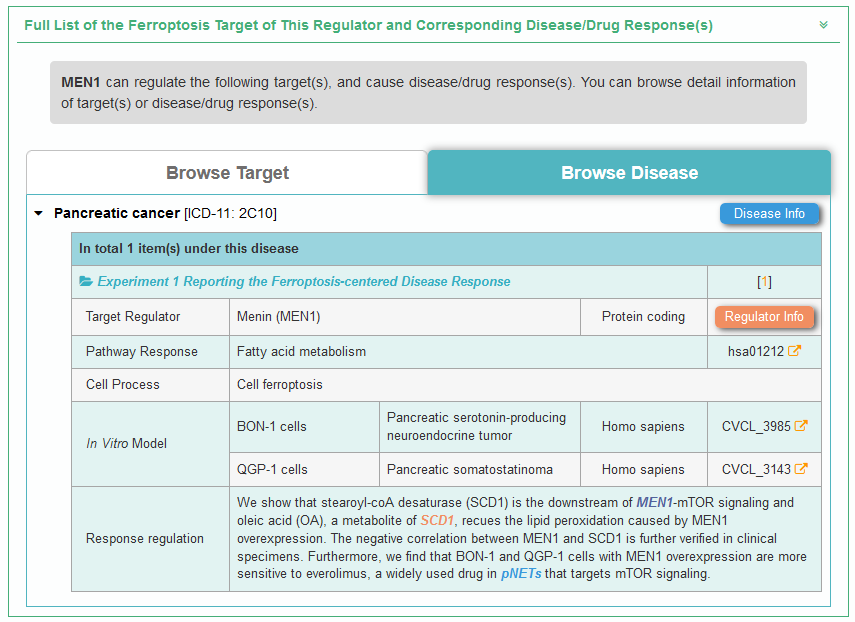A newly developed database, entitled “ferroptosis related regulation of diseases occurrence, progression and drug response (FERREG)”, was therefore constructed. First, a systematic literature review on ferroptosis’s regulation of disease occurrence, progression and drug response was conducted. As a result, the occurrence and development of a total of 87 disease classes (including diabetes mellitus, stroke, gastric cancer, chronic kidney disease, etc.) and the response data of 446 drugs (including sorafenib, everolimus, metformin, etc.) were identified to be affected by the ferroptosis pathway and thus systematically collected into our FERREG. Second, the molecular mechanisms underlying each regulation discussed above were then carefully retrieved from literatures. 66 ferroptosis targets were identified and clarified into three types, including ferroptosis marker (such as FTH1, HSPB1, NFE2L2, PTGS2, SLC40A1, TFRC), ferroptosis driver (such as GLS2, IREB2, ACSL1, ACSL4, NOX4, NCOA4, ALOX15), and ferroptosis suppressor (FTL, AIFM2, GCLM, GPX1, GCH1, HSPB1, NQO1, NFE2L2, SCD, VDAC3). A total of 599 ferroptosis regulators were identified, including 406 protein-coding regulators and 193 non-coding regulators (73 miRNA, 57 LncRNA, 46 cricRNA, 16 precursor RNA, 1 pseudogene), and more than 35 signaling pathways were comprehensively collected. Particularly, their regulation profiles (including target for ferroptosis, pathway response, regulated cell processes, etc.) and a total of 364 health or disease cell lines were provided. The data in FERREG were fully cross-linked to the well-established databases (such as UniProt, TTD, KEGG, NCBI Gene, and miRbase.
In the field of “Search for ferroptosis target”, users can find ferroptosis target entries by searching target name, ferroptosis regulator name, responsed disease name, responsed drug name, and so on among the entire textual component of FERREG. The query can be submitted by entering keywords into the main searching frame. The resulting webpage displays profiles of all the ferroptosis targets directly related to the search term, including Target Name, Target Type, ferroptosis Regulator, ferroptosis-centered Disease, ferroptosis-centered Drug, and ferroptosis target information link.
In order to facilitate a more customized input query, the wild characters of “*” and “?” are also supported.
(1) If search “GPX4”, find a single ferroptosis target entry which is named “GPX4”;
(2) If search “SIRT1”, find 4 entries with ferroptosis target names including “ACSL4” or "HMOX1" etc;
(3) If search: “Intracerebral hemorrhage”, finds 4 entries with ferroptosis target names including "SLC7A11" or "TP53" etc;
(4) If search: “Artesunate”, finds 3 entries with ferroptosis target names including "GPX4" or "NFE2L2" etc;
For example, if you want to know the detail information of title for GPX4, you can search “GPX4” in the “Search for ferroptosis target” field.

Search result of the “GPX4” shows the information of Target ID, Target Name, Target Type, Representative ferroptosis Regulator, Representative ferroptosis-centered Disease, Representative ferroptosis-centered Drug and External buttons. The “Target” button links to the detailed target information page of GPX4. The “Regulator Info” button links to the detailed ferroptosis regulator information page of TRIM21. The “Disease Info” button links to the detailed disease information page of Acute kidney failure. The “Drug Info” button links to the detailed disease information page of Fedratinib.

If you want to know the detail information of ferroptosis target, which regulated by STAT3, you can select "Signal transducer and activator of transcription 3 (STAT3)" in the "Search for ferroptosis target by regulator" field.

If you want to know the detail information of ferroptosis target, which effect on “Lung cancer”, you can select "2C25: Lung cancer " in the "Search for ferroptosis target by responsed disease" field.

If you want to know the detail information of ferroptosis target, which effect on “Curcumin”, you can select "Curcumin" in the "Search for ferroptosis target by drug" field.

1.1. By clicking the “Target” button, the detailed target information page for particular ferroptosis target will be displayed.
Take GPX4 as an example, “General Information of the ferroptosis Target” section displays the general information of GPX4, including its Name, Synonyms, Gene Name, Sequence, Family, Function, Gene ID, Uniprot ID, Target Type, Mechanism Diagram, and External Link(s).
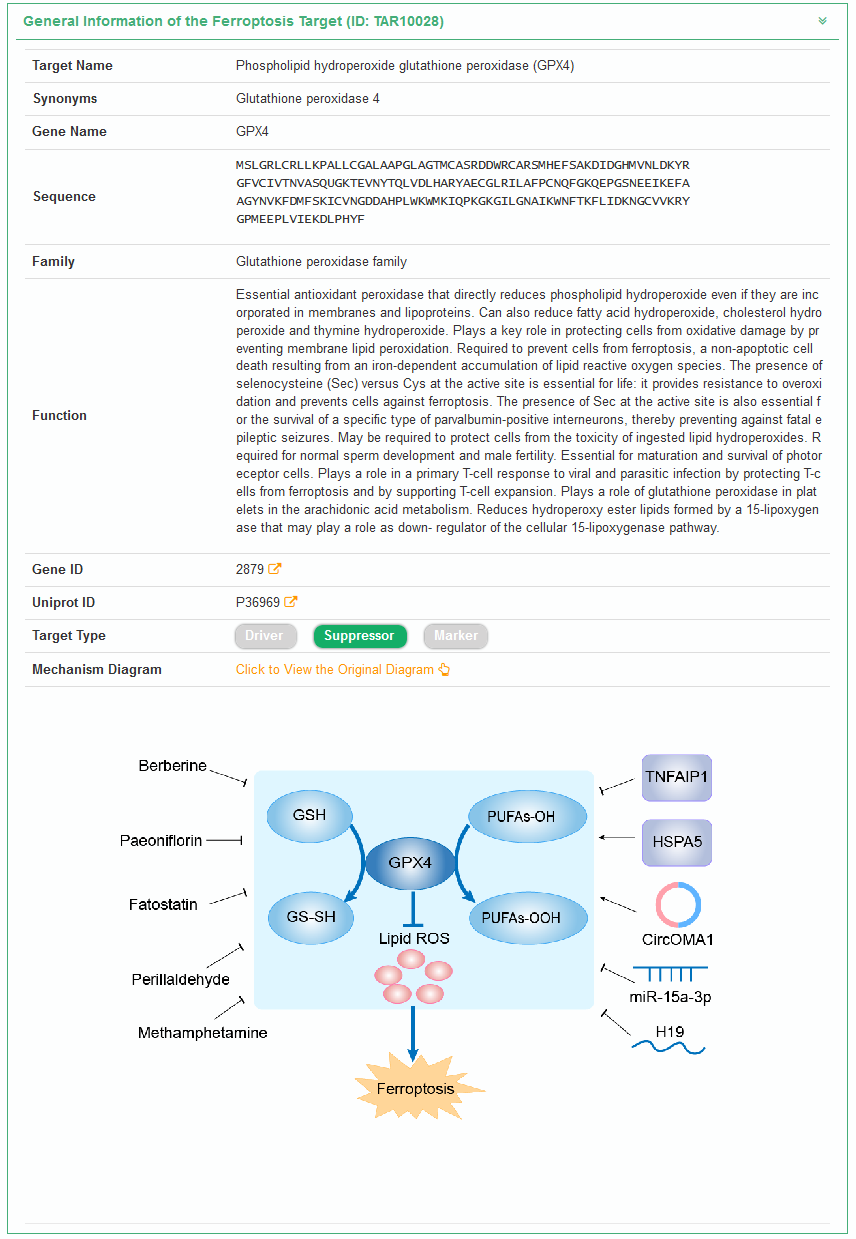
“Full List of ferroptosis Regulator of This Target and Corresponding Disease/Drug Response(s)” section displays the ferroptosis regulator(s) which regulate GPX4, and the corresponding Disease/Drug Response(s). Users can browse detail information of regulator(s) or disease/drug(s).
Browse through Disease, the followings are specific experiment reports about the ferroptosis-centered disease of this target.
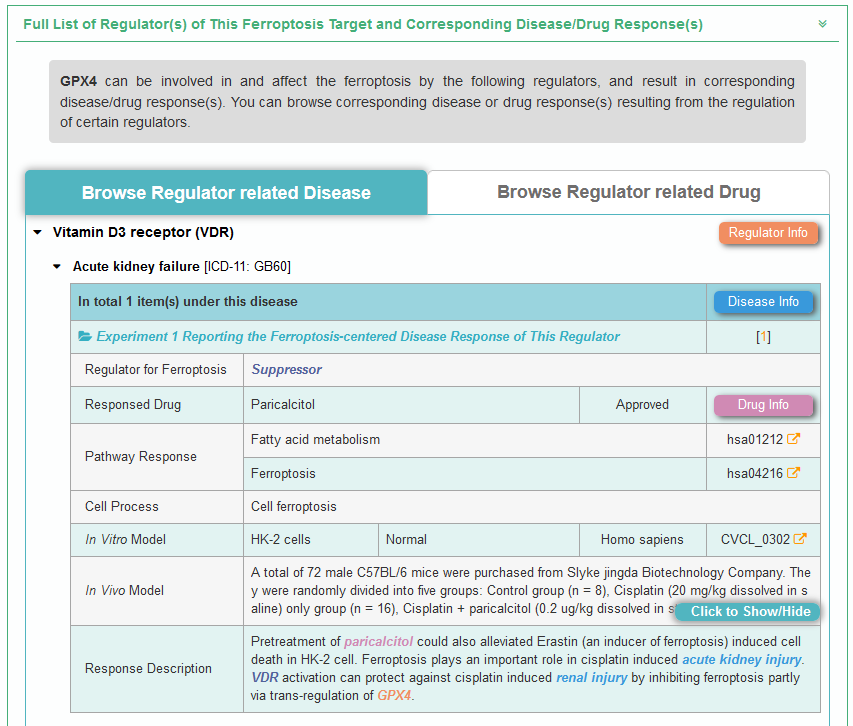
Browse through Drug, the followings are specific experiment reports about the ferroptosis-centered drug of this target.
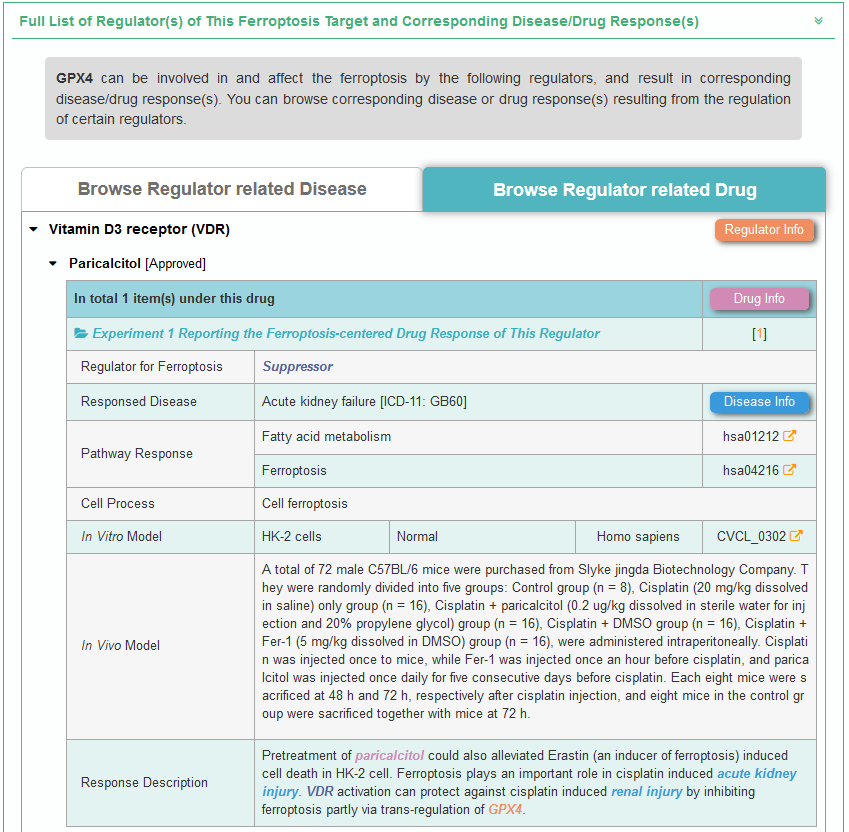
1.2. By clicking the “Regulator Info” button, the detailed ferroptosis regulator information page for particular representative ferroptosis regulator will be displayed.
Take H19 as an example, “General Information of the ferroptosis Regulator” section displays the general information of H19 which regulate GPX4, including its Name, Synonyms, Gene Name, Gene ID, Regulator Type, Ensembl ID, HGNC ID and External Link(s).
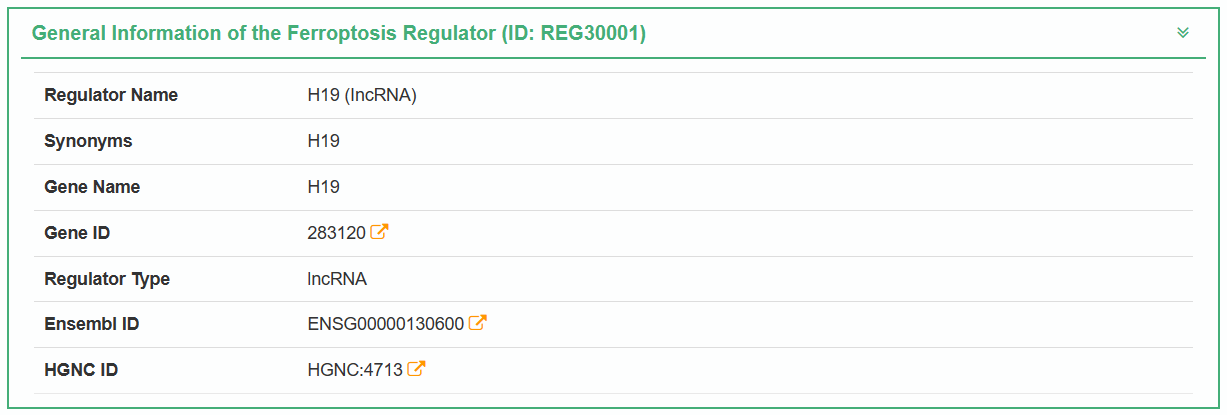
“Full List of ferroptosis Target of This Regulator and Corresponding Disease/Drug Response(s)” section displays the H19 which regulate ferroptosis Target(s), and the corresponding Disease/Drug Response(s). Users can browse detail information of Target(s) or disease/drug(s).
Browse through target, the followings are specific experiment reports about the target of this ferroptosis Regulator., including Target for Ferroptosis, Responsed Disease, Responsed Drug, Pathway Response, Cell Process, In-vitro Model, In-vivo Model, and Response regulation. Regulator Info button links to the detailed information page with the ferroptosis regulator. Disease Info button links to the detailed information page with the disease. Drug Info button links to the detailed information page with the drug.
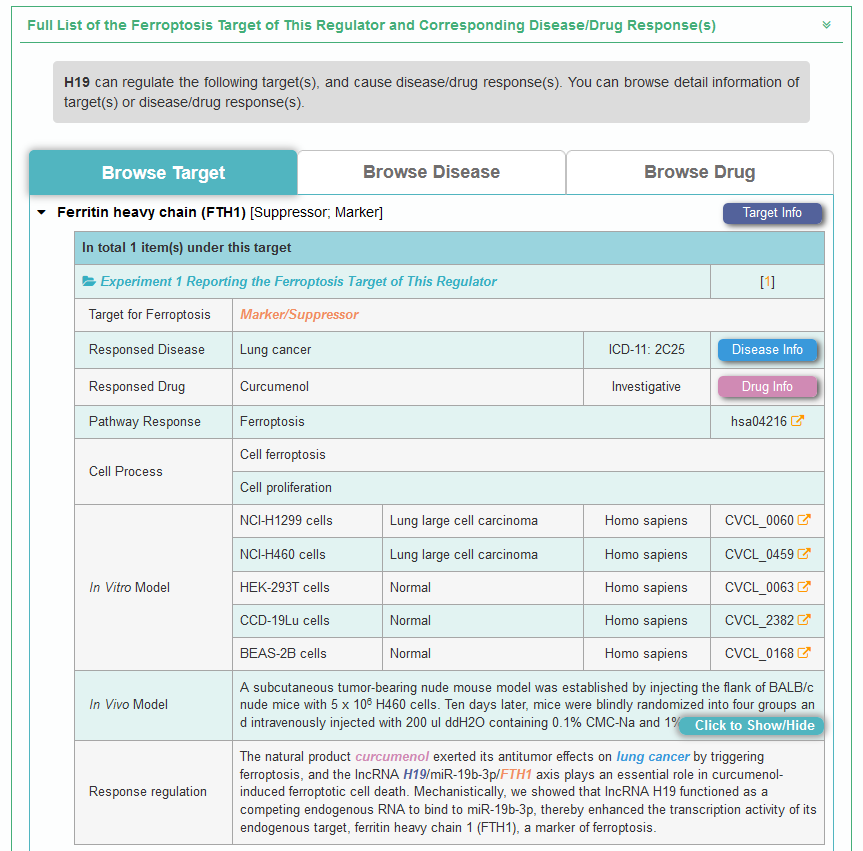
Browse through Disease, the followings are specific experiment reports about the ferroptosis-centered disease of this Regulator.
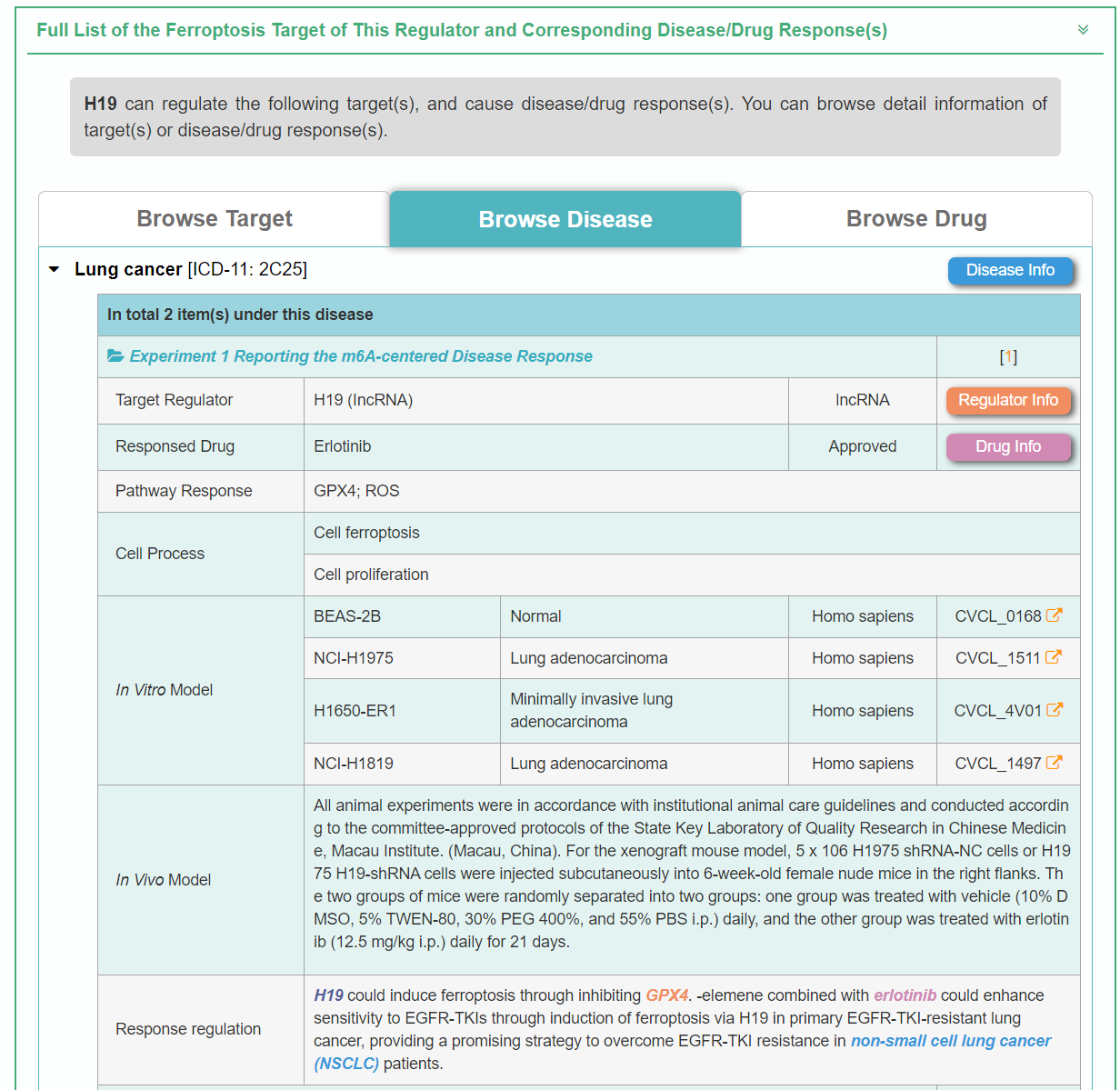
Browse through Drug, the followings are specific experiment reports about the ferroptosis-centered drug of this Regulator.
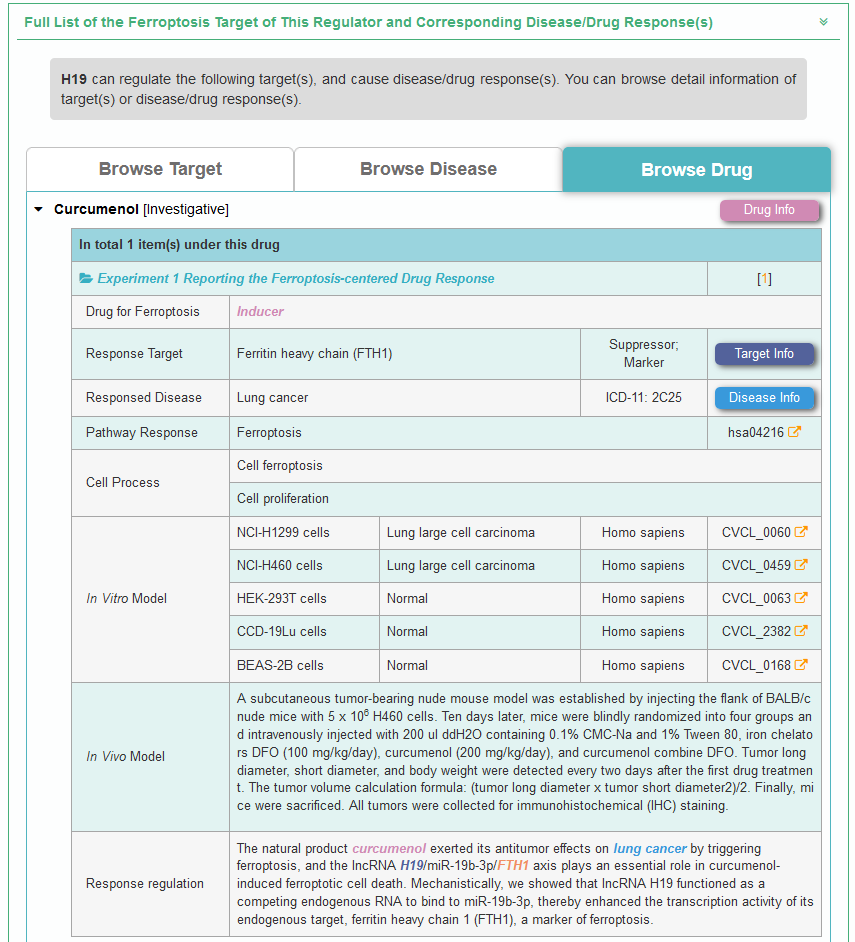
1.3. By clicking the “Disease Info” button, the detailed disease information page for particular “ferroptosis-centered Disease Information” will be displayed.
Take Glioblastoma as an example, “General Information of the Disease” section displays the general information of Glioblastoma which the GPX4 responds to, including its Name and ICD.

“Full List of Target(s) of This ferroptosis-centered Disease Response” section displays the target(s) of this ferroptosis-centered disease. The followings are specific experiment reportss about the ferroptosis-centered diseased by the target(s).
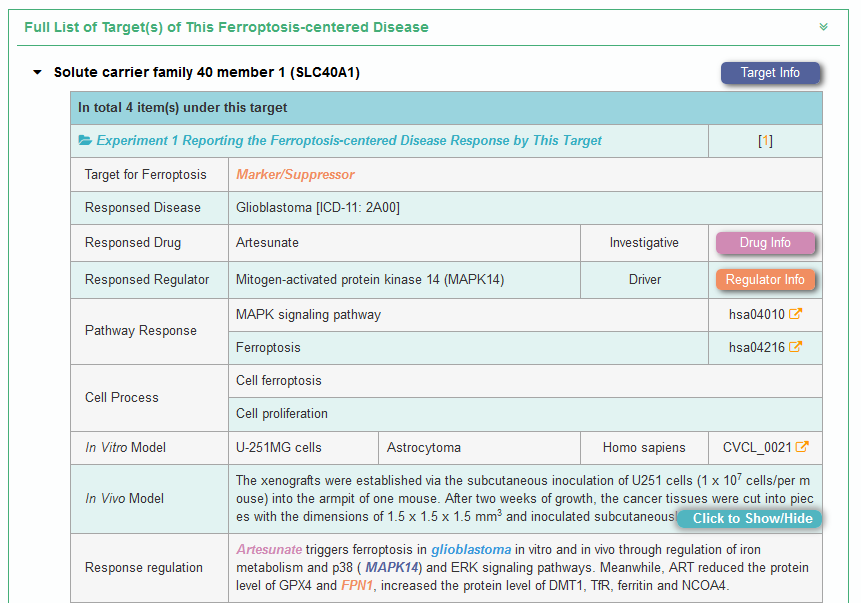
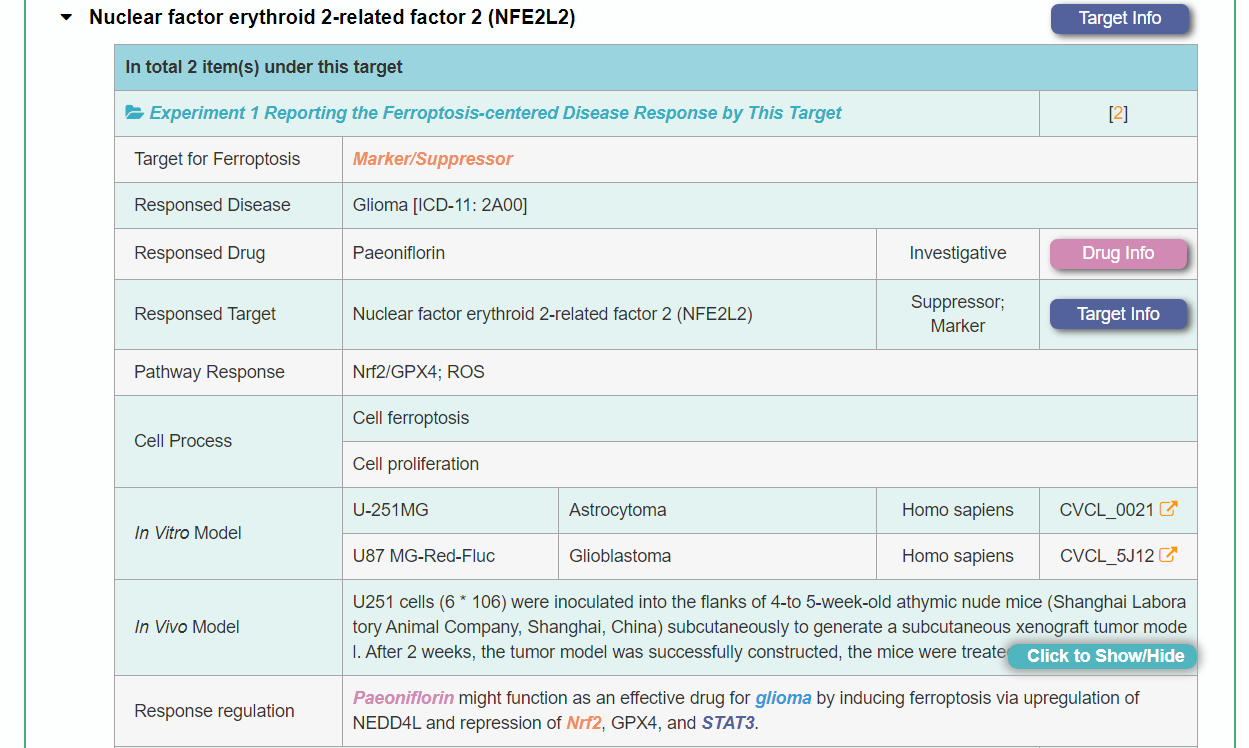
1.4. By clicking the “Drug Info” button, the detailed drug information page for particular “ferroptosis-centered Drug Information” will be displayed.
Take Metformin as an example, “General Information of the Drug” section displays the general information of Metformin which the GPX4 responds to, including its Name, Synonyms, Status, Drug Type, Structure, Formula, IUPAC Name, Canonical SMILES, InChI, InChIKey, PubChem CID, TTD Drug ID.
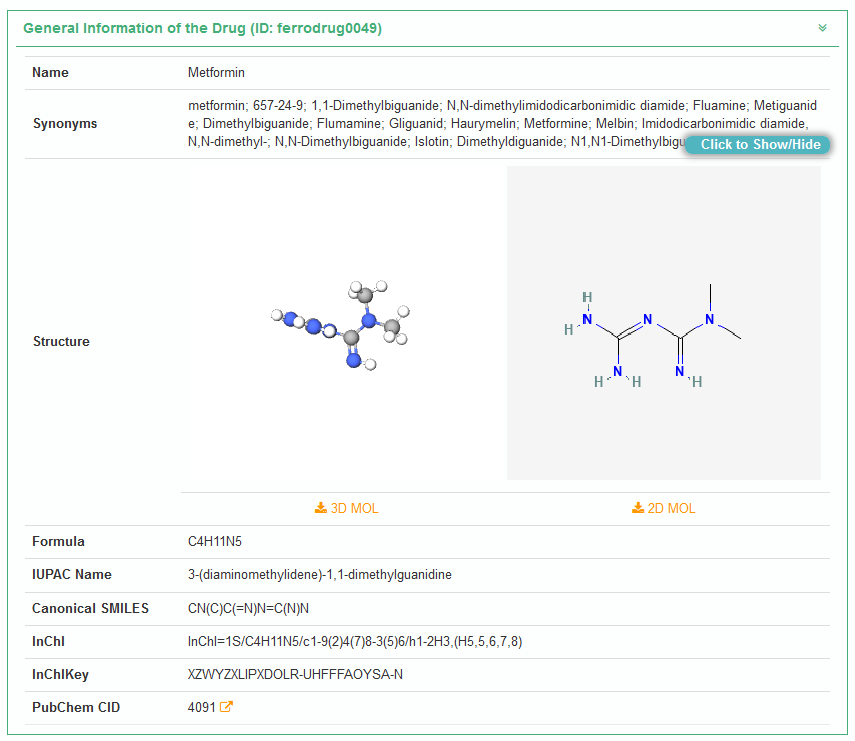
The followings are specific experiment reports about the ferroptosis-centered drug by the target(s).
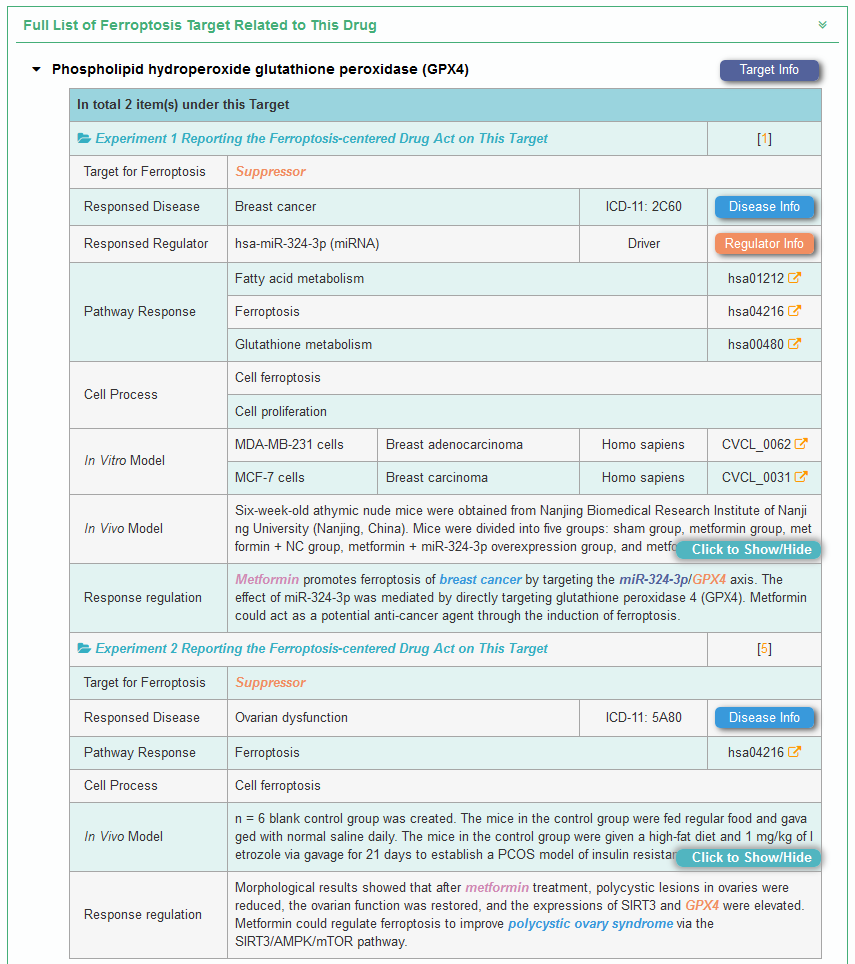
In the field of “Search for ferroptosis regulator”, users can find ferroptosis regulator entries by searching ferroptosis regulator name, target name, responsed disease name, responsed drug name, and so on among the entire textual component of FERREG. The query can be submitted by entering keywords into the main searching frame. The resulting webpage displays profiles of all the ferroptosis regulators directly related to the search term, including Regulator Name, Regulator Type, ferroptosis Target, ferroptosis-centered Disease, ferroptosis-centered Drug, and ferroptosis regulator information link.
In order to facilitate a more customized input query, the wild characters of “*” and “?” are also supported.
(1) If search “KLF15”, find a single ferroptosis regulator entry which is named “KLF15”;
(2) If search: “SLC7A11”, finds 19 entries with ferroptosis regulator names including "ATF3" or "MALT1" etc;
(3) If search: “Glioblastoma”, finds 8 entries with ferroptosis regulator names including "STAT3" or "NEDD4L" etc;
(4) If search: “Formononetin”, finds 3 entries with ferroptosis regulator names including "ATF3" or "SMAD3" etc;
For example, if you want to know the detail information of FERREG for KLF15, you can search “KLF15” in the “Search for ferroptosis regulator” field.

Search result of the “KLF15” shows the information of Regulator ID, Regulator Name, Regulator Type, Representative ferroptosis Target, Representative ferroptosis Regulator Response Disease, Representative ferroptosis Regulator Response Drug and External buttons. The “Regulator Info” button links to the detailed ferroptosis regulator information page of KLF15. The “Target” button links to the detailed target information page of GPX4. The “Disease Info” button links to the detailed disease information page of Cardiomyopathy. The “Drug Info” button links to the detailed disease information page of Elabela.
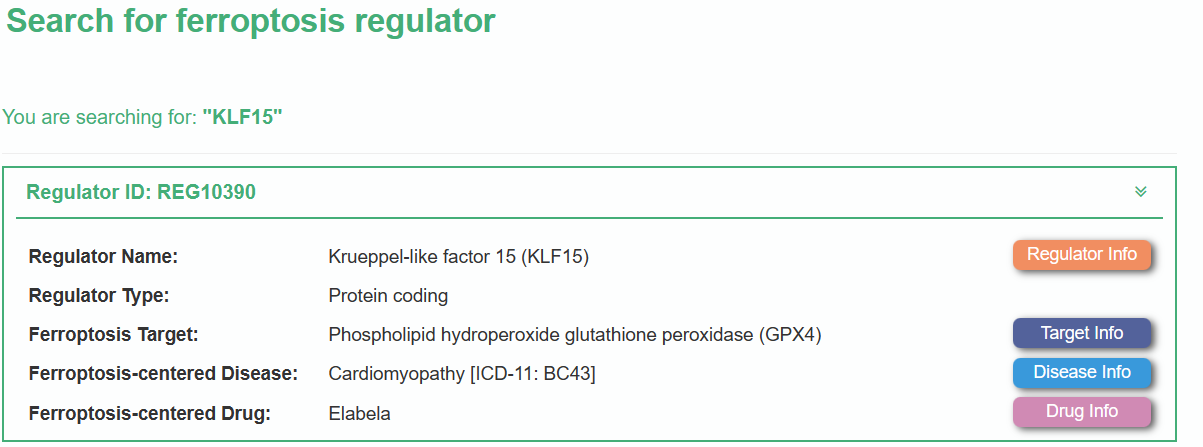
If you want to know the detail information of ferroptosis regulator, which targets “ACSL4”, you can select " Long-chain-fatty-acid--CoA ligase 4 (ACSL4) " in the "Search for ferroptosis regulator by target" field.

If you want to know the detail information of ferroptosis regulator, which regulate “Ovarian cancer”, you can select "2C73: Ovarian cancer " in the "Search for ferroptosis regulator by responsed disease" field.

If you want to know the detail information of ferroptosis regulator, which regulate “Baicalein”, you can select " Baicalein" in the "Search for ferroptosis regulator by responsed drug" field.

2.1. By clicking the “Regulator Info” button, the detailed ferroptosis regulator information page for particular ferroptosis regulator will be displayed.
Take KLF15 as an example, “General Information of the ferroptosis Regulator” section displays the general information of KLF15 including its Name, Synonyms, Gene Name, Gene ID, Regulator Type, Sequence, Family, Function, HGNC ID, KEGG ID, and External Link(s).
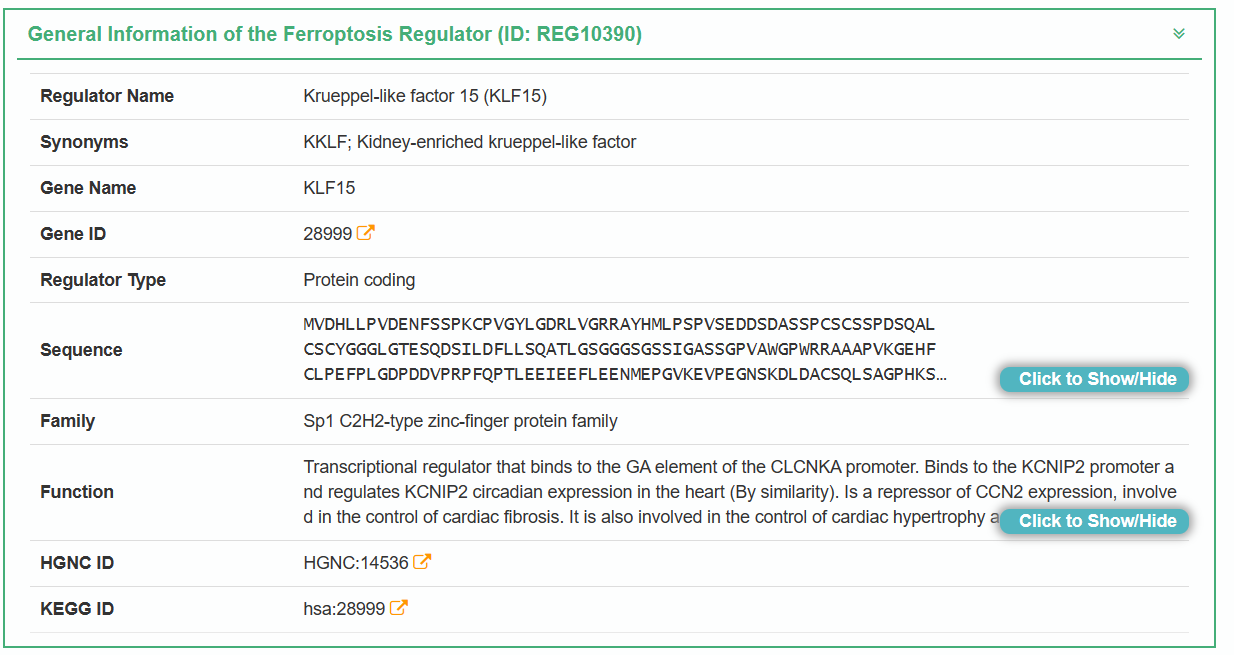
“Full List of ferroptosis target of This ferroptosis Regulator and Corresponding Disease/Drug Response(s)” section displays the KLF15 which regulate ferroptosis target(s), and the corresponding Disease/Drug Response(s). User can browse detail information of regulator(s) or disease/drug(s).
Browse through target, the followings are specific experiment reports about the target of this ferroptosis Regulator, including Target for Ferroptosis, Responsed Disease, Responsed Drug, Pathway Response, Cell Process, In-vitro Model, and Response regulation. Target Info button links to the detailed information page with the ferroptosis target. Disease Info button links to the detailed information page with the disease. Drug Info button links to the detailed information page with the drug.
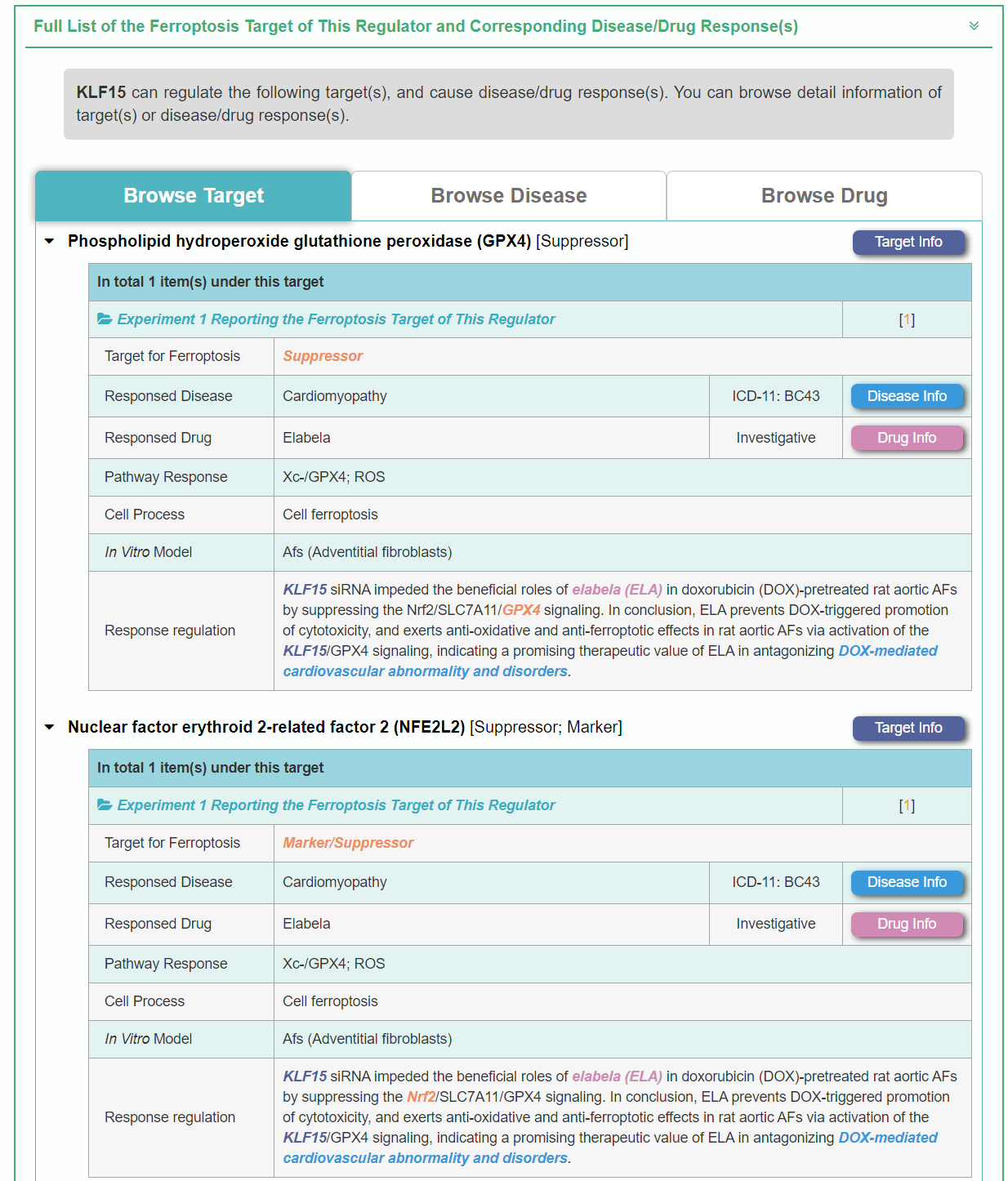
Browse through Disease, the followings are specific experiment reportss about the ferroptosis-centered disease of this ferroptosis Regulator, including Target Regulator, Responsed Drug, Pathway Response, Cell Process, In-vitro Model, and Response regulation. Disease Info button links to the detailed information page with the disease. Regulator Info button links to the detailed information page with the ferroptosis regulator. Drug Info button links to the detailed information page with the drug.
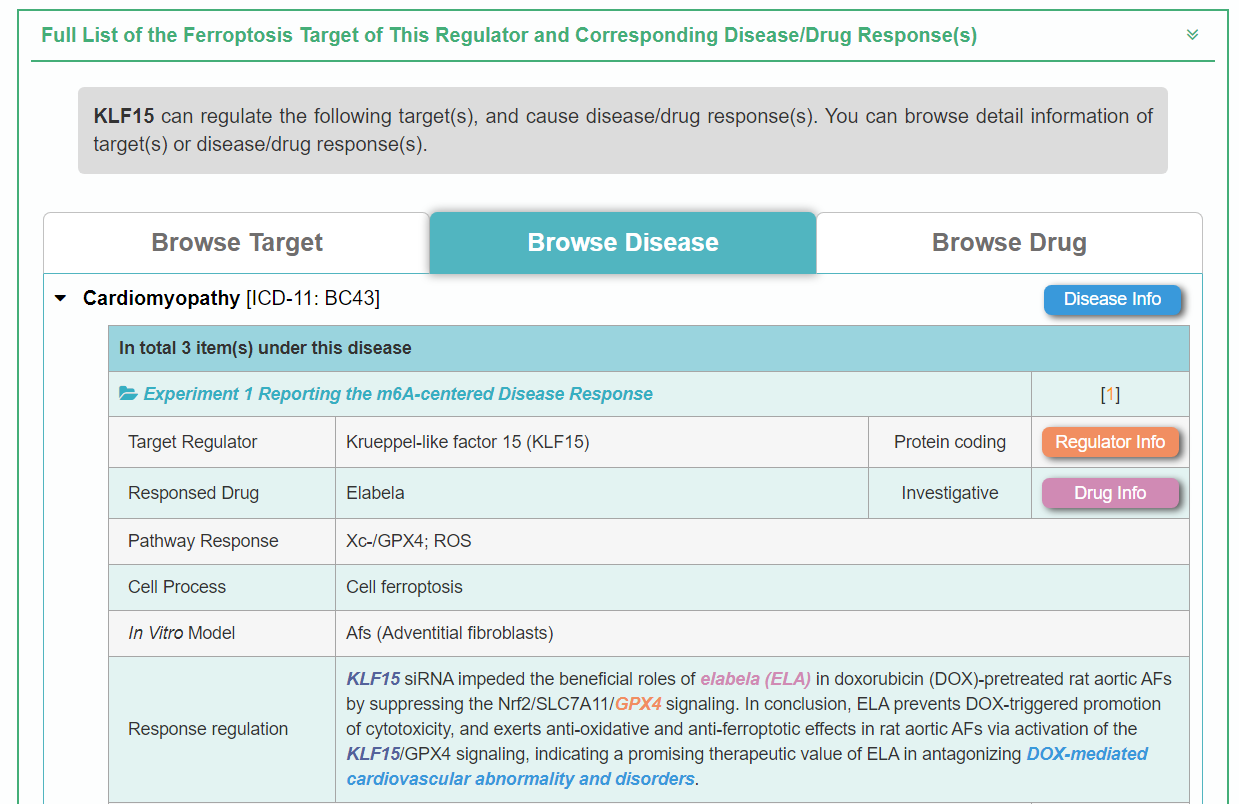
Browse through Drug, the followings are specific experiment reportss about the ferroptosis-centered drug of this Regulator, including Drug to Ferroptosis, Response Target, Responsed Disease, Pathway Response, Cell Process, In-vitro Model, and Response regulation. Drug Info button links to the detailed information page with the drug. Target Info button links to the detailed information page with the ferroptosis target. Disease Info button links to the detailed information page with the disease.
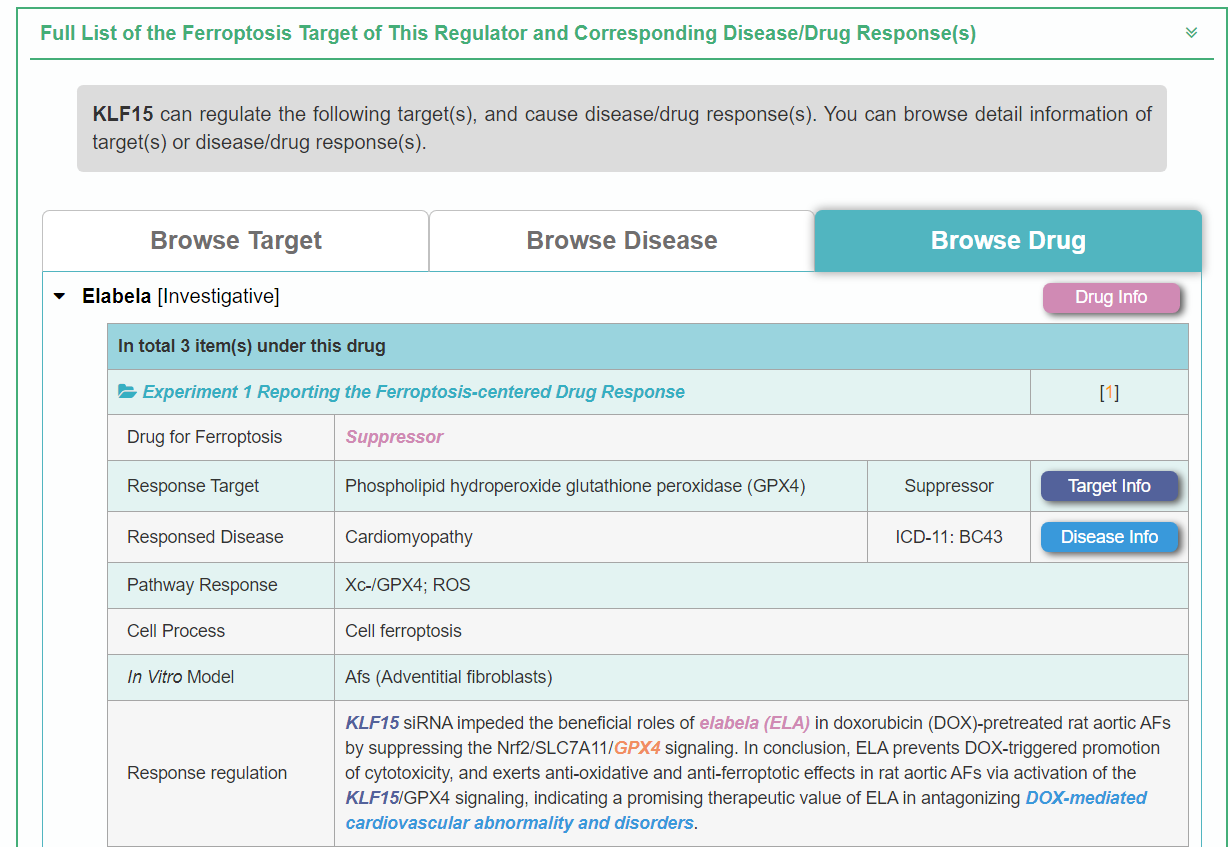
2.2. By clicking the “Target” button, the detailed target information page for particular ferroptosis regulator target will be displayed.
Take GPX4 as an example, “General Information of the ferroptosis Target” section displays the general information of GPX4 which regulated by KLF15, including its Name, Synonyms, Gene Name, Sequence, Family, Function, Gene ID, Uniprot ID, Target Type, Mechanism Diagram, and External Link(s).
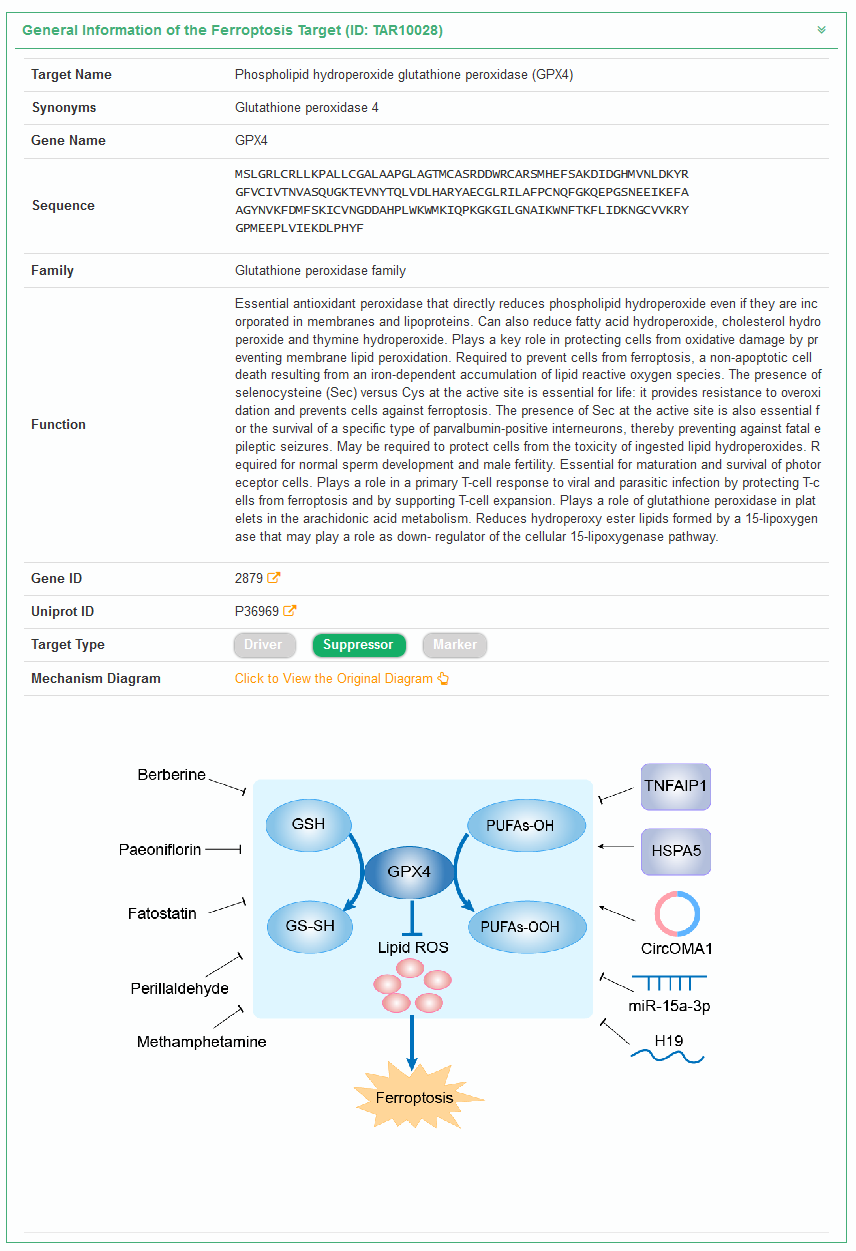
“Full List of ferroptosis Regulator of This Target and Corresponding Disease/Drug Response(s)” section displays the ferroptosis regulator(s) which regulate GPX4, and the corresponding Disease/Drug Response(s). Users can browse detail information of regulator(s) or disease/drug(s).
Browse through Disease, the followings are specific experiment reports about the ferroptosis-centered disease of this target.
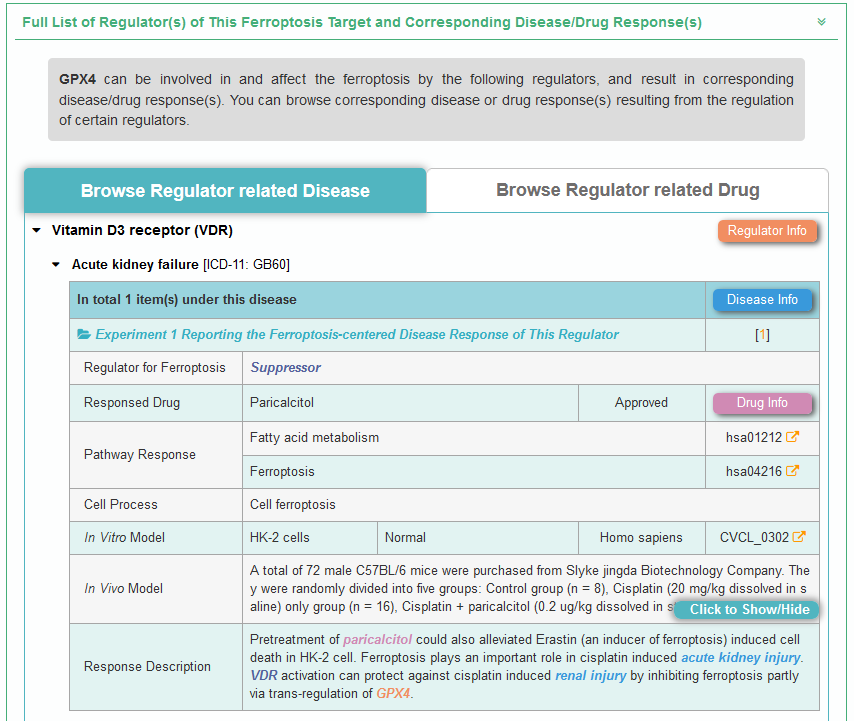
Browse through Drug, the followings are specific experiment reports about the ferroptosis-centered drug of this target.
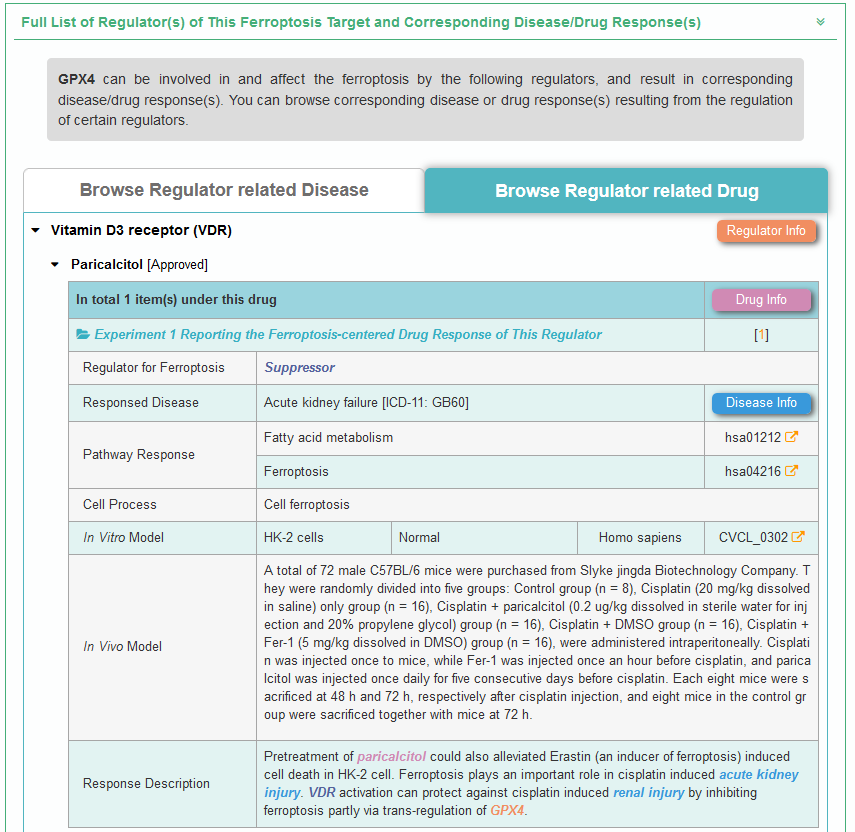
2.3. By clicking the “Disease Info” button, the detailed disease information page for particular “ferroptosis-centered Disease Information” will be displayed.
Take Cardiomyopathy as an example, “General Information of the Disease” section displays the general information of Cardiomyopathy which the KLF15 responds to, including its Name and ICD.

“Full List of Target(s) of This ferroptosis-centered Disease Response” section displays the target(s) of this ferroptosis-centered disease. The followings are specific experiment reportss about the ferroptosis-centered disease by the target(s), including Target for Ferroptosis, Responsed Disease, Responsed Drug, Pathway Response, Cell Process, In-vitro Model,and Response regulation. Target Info button links to the detailed information page with the target. Drug Info button links to the detailed information page with the drug.
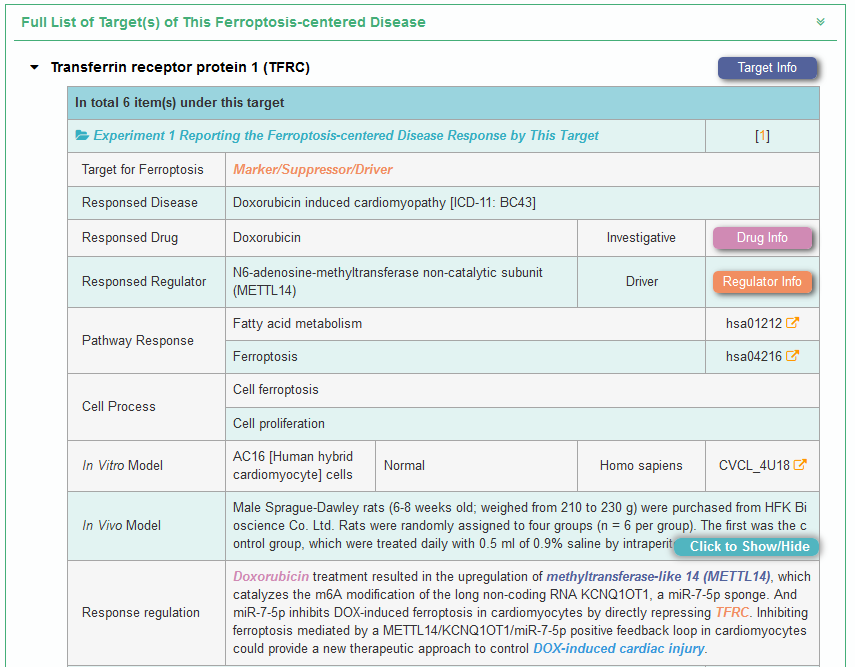
2.4. By clicking the “Drug Info” button, the detailed drug information page for particular “ferroptosis-centered Drug Information” will be displayed.
Take Elabela as an example, “General Information of the Drug” section displays the general information of Elabela to which the KLF15 responds, including its Name, Synonyms, Status, Drug Type, Structure, Formula, IUPAC Name, Canonical SMILES, InChI, InChIKey, PubChem CID, TTD Drug ID.
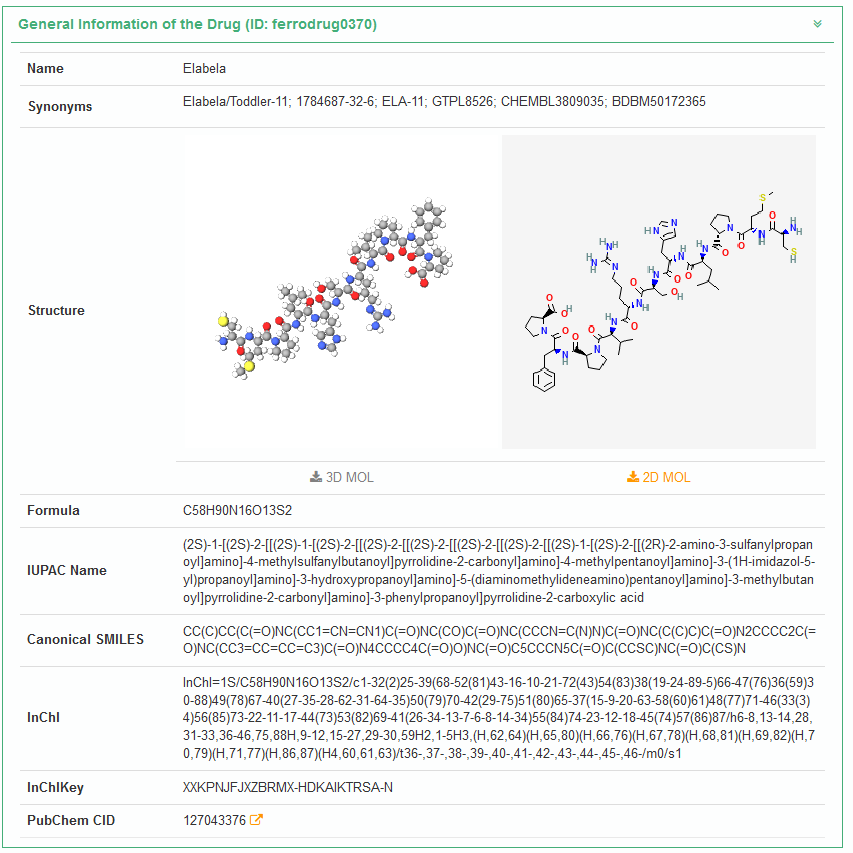
“Full List of ferroptosis Regulator with Target” section displays the target(s) of this ferroptosis-centered drug. The followings are specific experiment reportss about the ferroptosis-centered drug by the target(s), including Target for Ferroptosis, Responsed Disease, Responsed Regulator, Pathway Response, Cell Process, In-vitro Model, and Response regulation. Target Info button links to the detailed information page with the target. Disease Info button links to the detailed information page with the disease. Regulator Info button links to the detailed information page with the ferroptosis regulator.
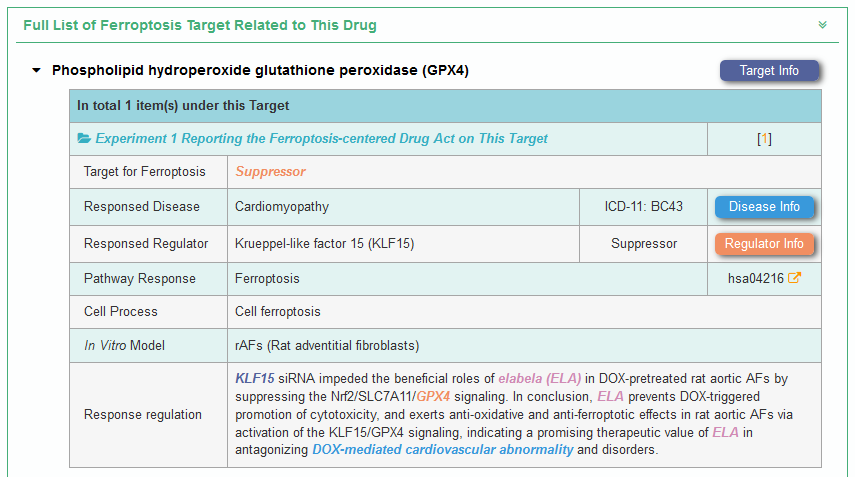
In the field of “Search for ferroptosis-centered disease”, users can find ferroptosis-centered disease entries by searching disease name, ferroptosis regulator name, target name, responsed drug name, and so on among the entire textual component of FERREG. The query can be submitted by entering keywords into the main searching frame. The resulting webpage displays profiles of all the ferroptosis-centered disease directly related to the search term, including Disease Name, Disease ICD, ferroptosis Target, ferroptosis-centered Drug, ferroptosis Regulator and ferroptosis-centered disease information link.
In order to facilitate a more customized input query, the wild characters of “*” and “?” are also supported.
(1) If search “Gastric cancer”, find a single ferroptosis-centered disease entry which is named “Gastric cancer”;
(2) If search “ACSL4”, finds 12 entries with ferroptosis-centered disease names including “Pancreatic cancer” or “Breast cancer” etc;
(3) If search: “MTOR”, finds 4 entries with ferroptosis-centered disease names including "Glioblastoma" or "Lung cancer" etc;
(4) If search: “Baicalein”, finds 4 entries with ferroptosis-centered disease names including "Osteosarcoma" or "Endometriosis" etc;

For example, if you want to know the detail information of FERREG for Gastric cancer, you can search “Gastric cancer” in the “Search for ferroptosis-centered disease” field.

Search result of the “Gastric cancer” shows the information of Disease Name, Disease ICD, Representative ferroptosis Drug, Representative ferroptosis Regulator and External buttons. The “Disease Info” button links to the detailed disease information page of Gastric cancer. The “Regulator Info” button links to the detailed ferroptosis regulator information page of E2F7. The “Drug Info” button links to the detailed disease information page of Dexmedetomidine.

If you want to know the detail information of ferroptosis-centered disease, which effected by “ACSL4”, you can select "Long-chain-fatty-acid--CoA ligase 4 (ACSL4)" in the "Search for ferroptosis-centered disease by target" field.

If you want to know the detail information of ferroptosis-centered disease, which regulated by “KEAP1”, you can select "Kelch-like ECH-associated protein 1 (KEAP1)" in the "Search for ferroptosis-centered disease by regulator" field.

If you want to know the detail information of ferroptosis-centered disease, which related to “Salidroside”, you can select "Salidroside" in the "Search for ferroptosis-centered disease by responsed drug" field.

3.1. By clicking the “Disease Info” button, the detailed disease information page for particular “ferroptosis-centered Disease Information” will be displayed.
Take Gastric cancer as an example, “General Information of the Disease” section displays the general information of Gastric cancer, including its Name and ICD.

“Full List of Target(s) of This ferroptosis-centered Disease Response” section displays the target(s) of this ferroptosis-centered disease. The followings are specific experiment reportss about the ferroptosis-centered diseased by the target(s).
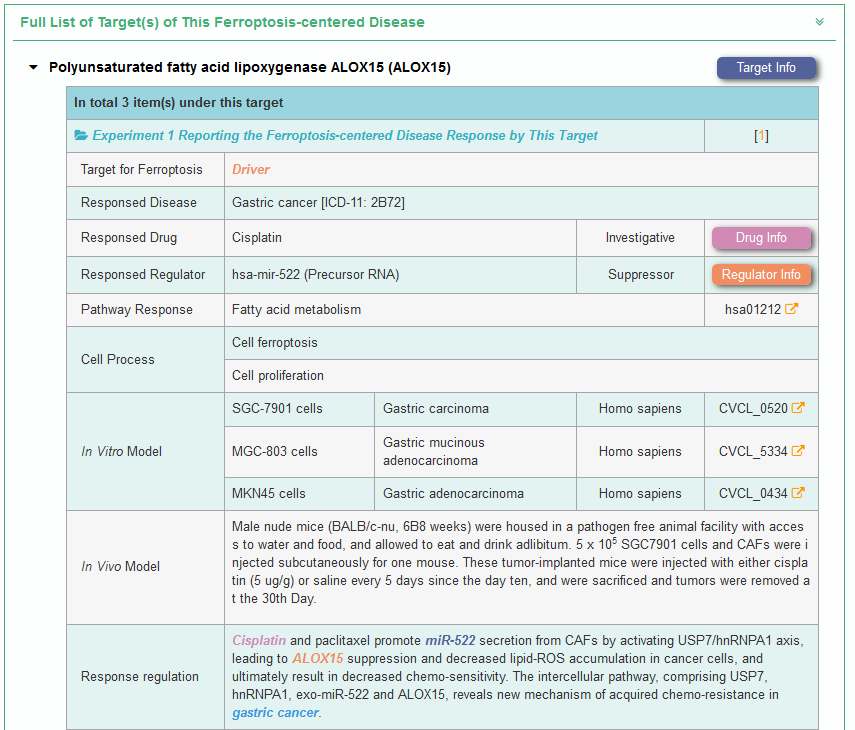
3.2. By clicking the “Target” button, the detailed target information page for particular ferroptosis regulator target will be displayed.
Take TFRC as an example, “General Information of the ferroptosis Target” section displays the general information of TFRC which effect on Gastric cancer, including its Name, Synonyms, Gene Name, Sequence, Family, Function, Gene ID, Uniprot ID, Target Type, Mechanism Diagram, and External Link(s).
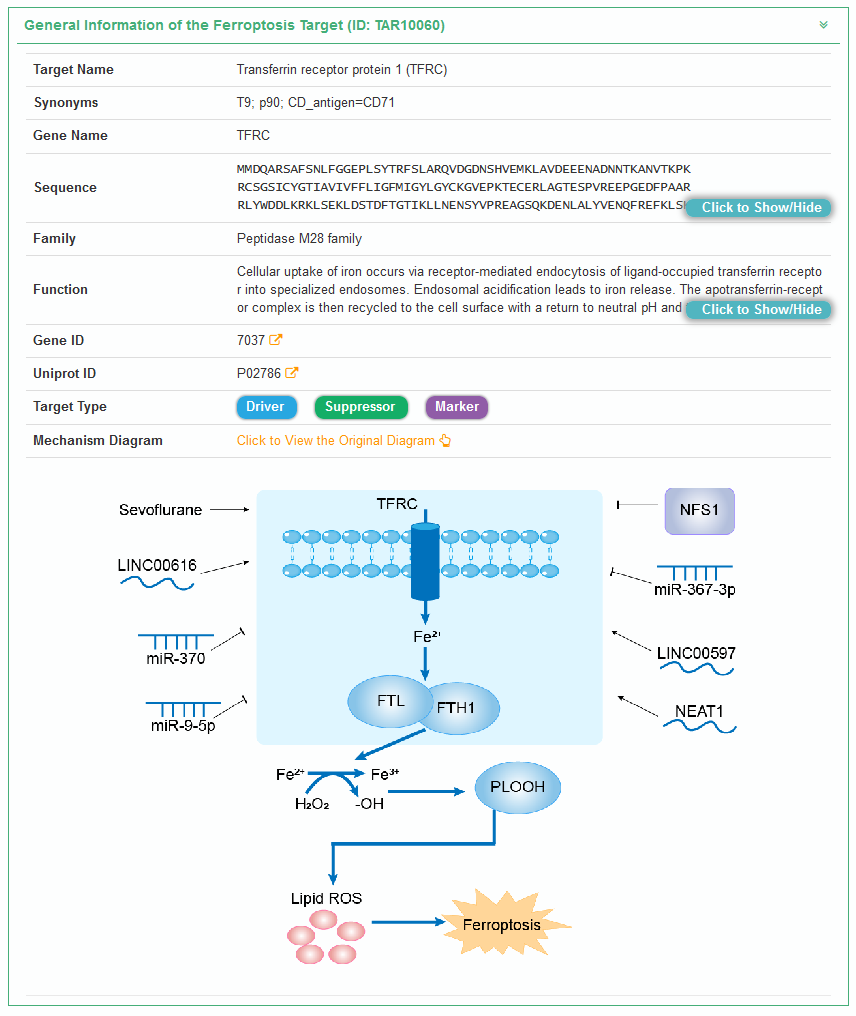
“Full List of ferroptosis Regulator of This Target and Corresponding Disease/Drug Response(s)” section displays the ferroptosis regulator(s) which regulate TFRC, and the corresponding Disease/Drug Response(s). Users can browse detail information of regulator(s) or disease/drug(s).
Browse through Disease, the followings are specific experiment reports about the ferroptosis-centered disease of this target.
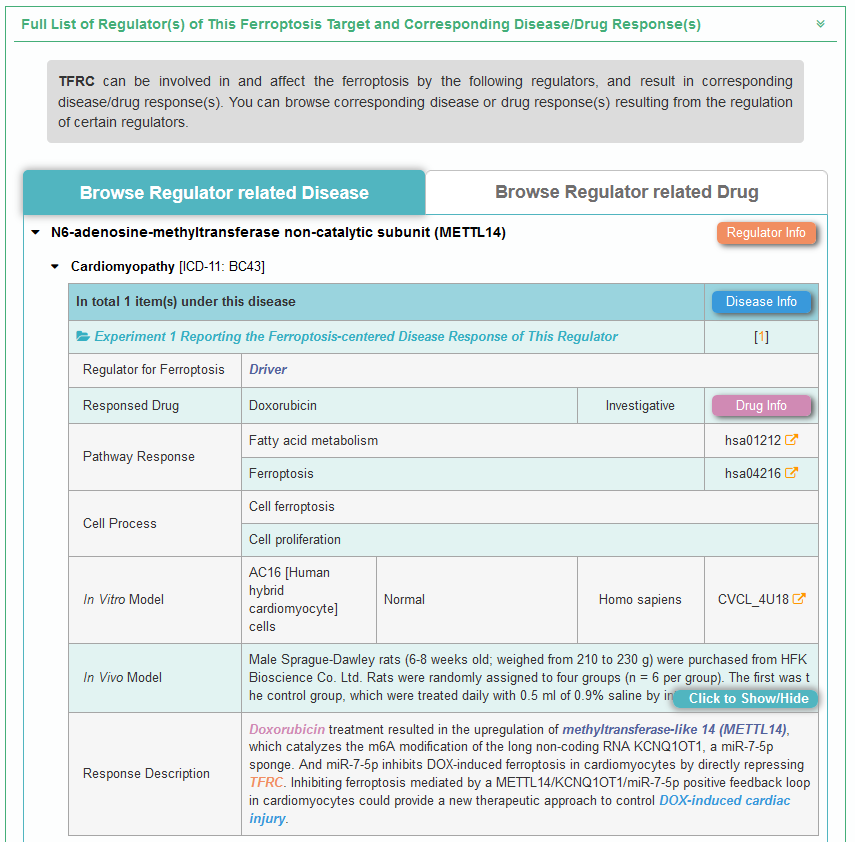
Browse through Drug, the followings are specific experiment reports about the ferroptosis-centered drug of this target.
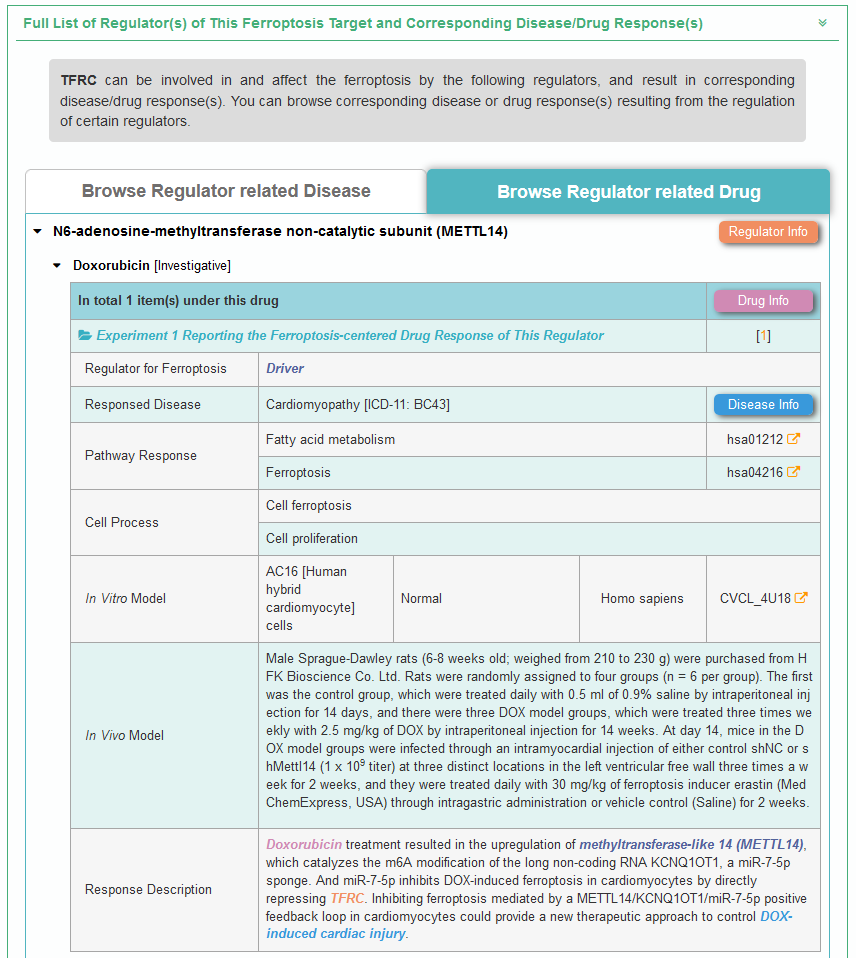
3.3. By clicking the “Regulator Info” button, the detailed ferroptosis regulator information page for particular ferroptosis regulator will be displayed.
Take FBXW7 as an example, “General Information of the ferroptosis Regulator” section displays the general information of FBXW7 which regulate Gastric cancer, including its Name, Synonyms, Gene Name, Gene ID, Regulator Type, Sequence, Family, Function, HGNC ID, KEGG ID, and External Link(s).
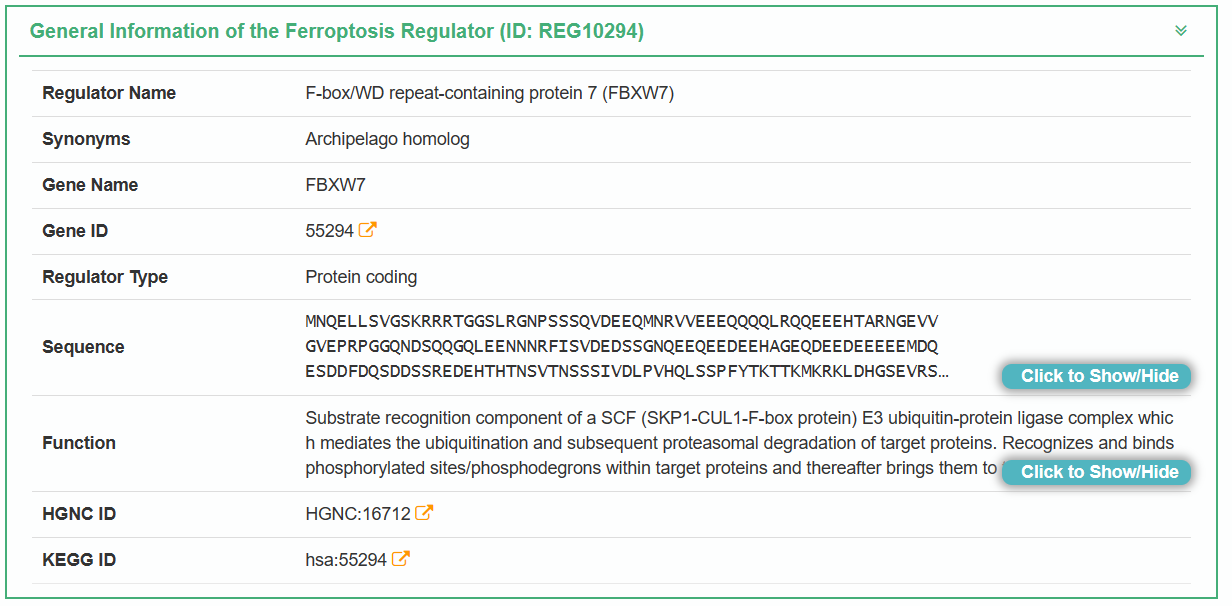
“Full List of ferroptosis target of This ferroptosis Regulator and Corresponding Disease/Drug Response(s)” section displays the FBXW7 which regulate ferroptosis target(s), and the corresponding Disease/Drug Response(s). User can browse detail information of regulator(s) or disease/drug(s).
Browse through target, the followings are specific experiment reports about the target of this ferroptosis Regulator, including Target for Ferroptosis, Responsed Disease, Pathway Response, Cell Process, In-vitro Model, In-vivo Model and Response regulation. Target Info button links to the detailed information page with the ferroptosis target. Disease Info button links to the detailed information page with the disease.
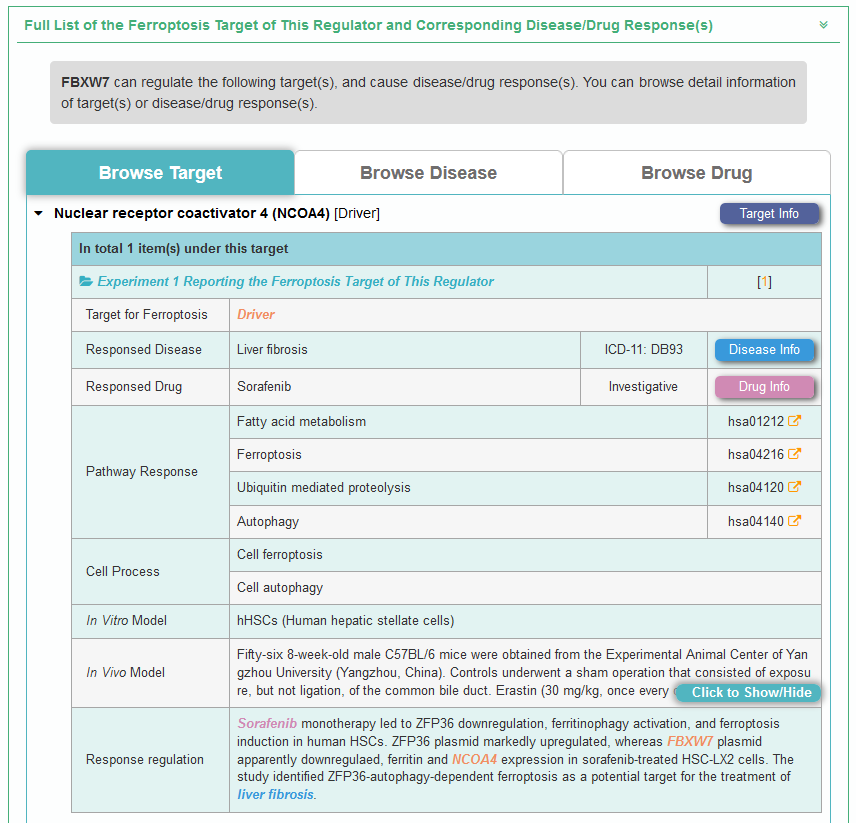
Browse through Disease, the followings are specific experiment reportss about the ferroptosis-centered disease of this ferroptosis Regulator, including Target Regulator, Pathway Response, Cell Process, In-vitro Model, In-vivo Model, and Response regulation. Disease Info button links to the detailed information page with the disease. Regulator Info button links to the detailed information page with the ferroptosis regulator.
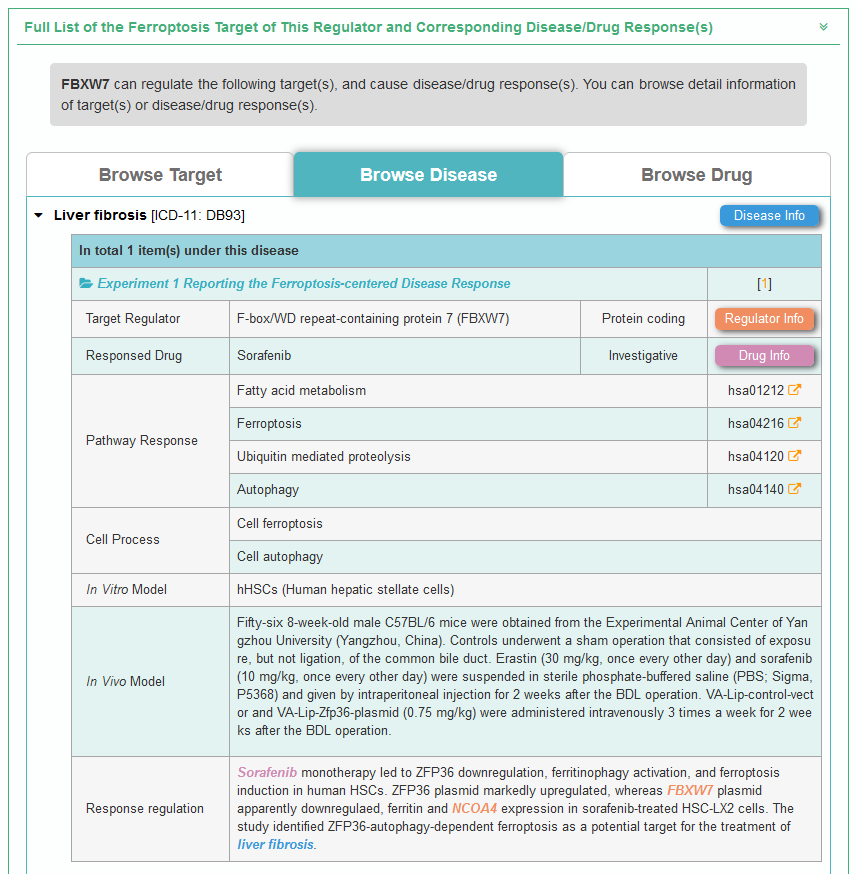
3.4. By clicking the “Drug Info” button, the detailed drug information page for particular “ferroptosis-centered Drug Information” will be displayed.
Take Metformin as an example, “General Information of the Drug” section displays the general information of Diosgenin tetraglycoside which the gastric cancer related with, including its Name, Synonyms, Status, Drug Type, Structure, Formula, IUPAC Name, Canonical SMILES, InChI, InChIKey, PubChem CID, TTD Drug ID.
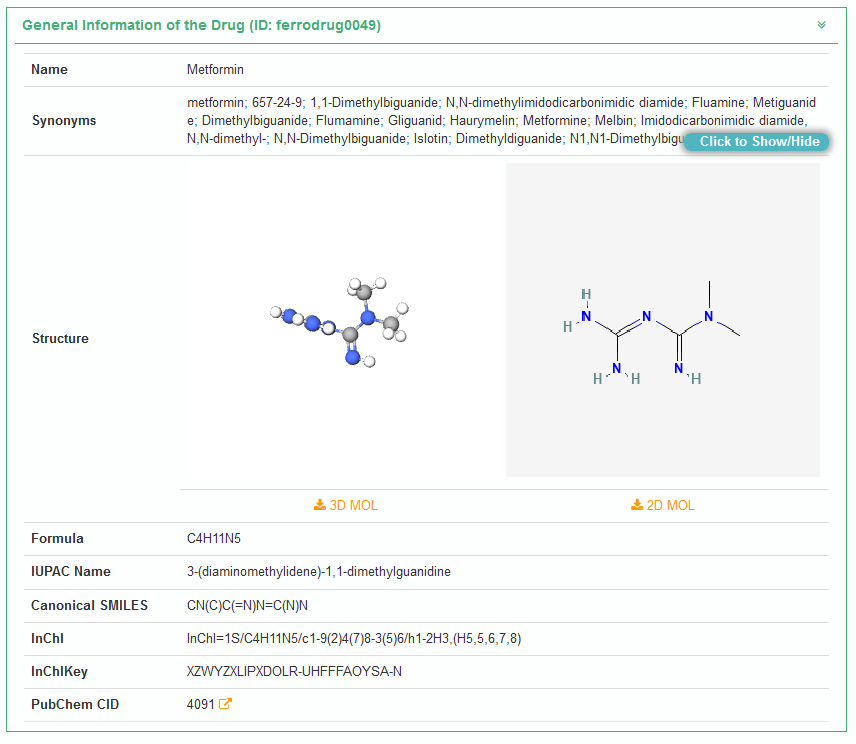
The followings are specific experiment reports about the ferroptosis-centered drug by the target(s).
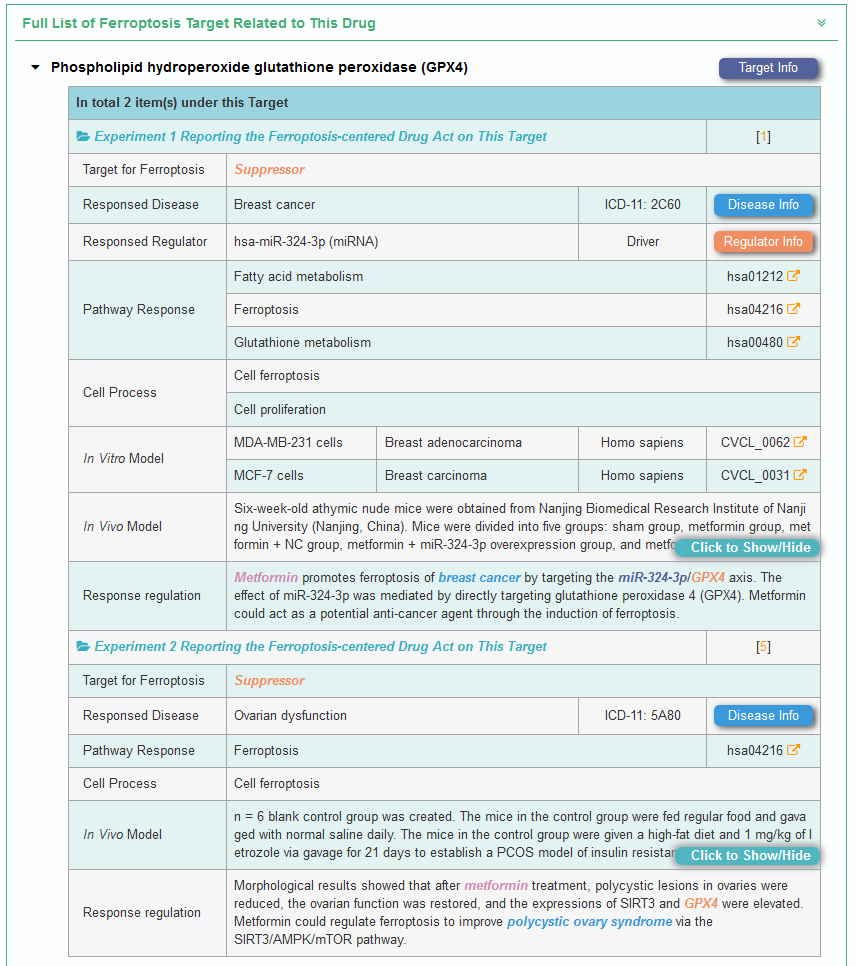
In the field of “Search for ferroptosis-centered drug”, users can find ferroptosis-centered drug entries by searching drug name, ferroptosis regulator name, target name, responsed disease name, and so on among the entire textual component of FERREG. The query can be submitted by entering keywords into the main searching frame. The resulting webpage displays profiles of all the ferroptosis-centered drug directly related to the search term, including Drug Name, Drug Status, ferroptosis Target, ferroptosis-centered Disease, ferroptosis Regulator and ferroptosis-centered disease information link.
In order to facilitate a more customized input query, the wild characters of “*” and “?” are also supported.
(1) If search “Everolimus”, find a single ferroptosis-centered drug entry which is named “Everolimus”;
(2) If search “ACSL4”, finds 10 ferroptosis-centered drug entries including “Sevoflurane” or “Icariin”;
(3) If search: “Glioblastoma”, finds 2 entries with ferroptosis-centered drug names including "Fatostatin" or "Paeoniflorin" etc;
(4) If search: “MT-CO2”, finds 2 entries with ferroptosis-centered drug names including "Aspirin" or "Epigallocatechin Gallate" etc;

For example, if you want to know the detail information of FERREG for Everolimus, you can search “Everolimus” in the “Search for ferroptosis-centered drug” field.

Search result of the “Everolimus” shows the information of Drug Name, Drug Status, Representative ferroptosis Target, Representative ferroptosis-centered Disease, Representative ferroptosis Regulator and External buttons. The “Drug Info” button links to the detailed disease information page of Everolimus.
The “Disease Info” button links to the detailed disease information page of Pancreatic cancer. The “Target” button links to the detailed target information page of SCD. The “Regulator Info” button links to the detailed ferroptosis regulator information page of MEN1.

If you want to know the detail information of ferroptosis-centered drug, which effected by “SCD”, you can select "Stearoyl-CoA desaturase (SCD)" in the "Search for ferroptosis-centered drug by target" field.

If you want to know the detail information of ferroptosis-centered drug, which related to “Pancreatic cancer”, you can select "2C10: Pancreatic cancer" in the "Search for ferroptosis-centered drug by responsed disease" field.

If you want to know the detail information of ferroptosis-centered drug, which regulated by “MT-CO2”, you can select "Cytochrome c oxidase subunit 2 (MT-CO2)" in the "Search for ferroptosis-centered drug by regulator" field.

4.1. By clicking the “Drug Info” button, the detailed drug information page for particular “ferroptosis-centered Drug Information” will be displayed.
Take Everolimus as an example, “General Information of the Drug” section displays the general information of Diosgenin tetraglycoside which the Pancreatic cancer related with, including its Name, Synonyms, Status, Drug Type, Structure, Formula, IUPAC Name, Canonical SMILES, InChI, InChIKey, PubChem CID, TTD Drug ID.
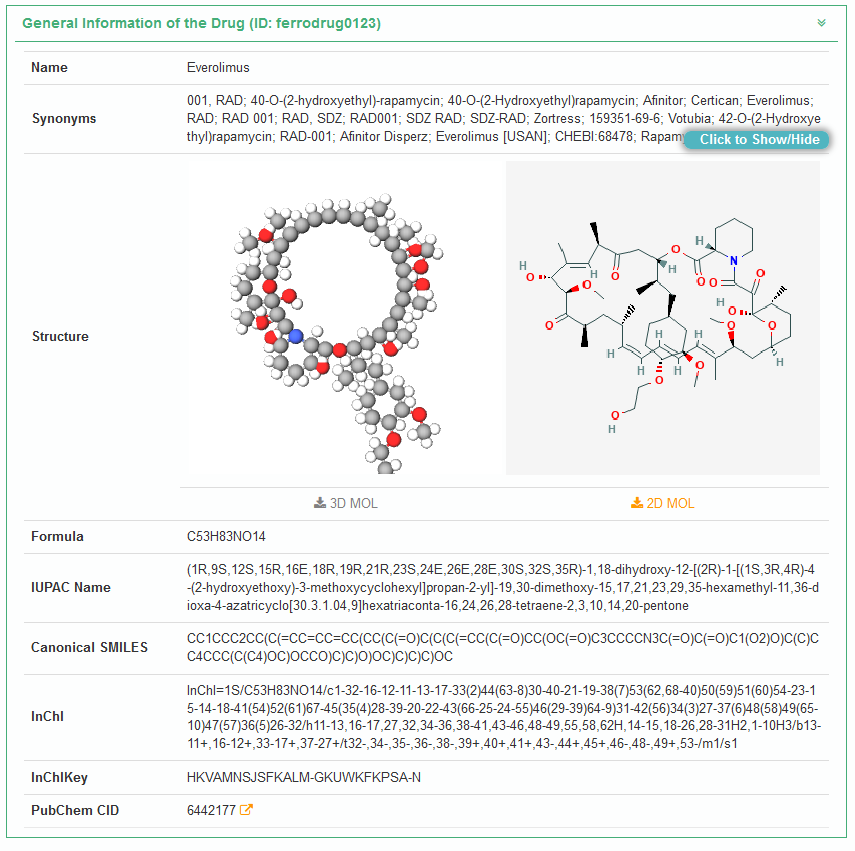
The followings are specific experiment reports about the ferroptosis-centered drug by the target(s).
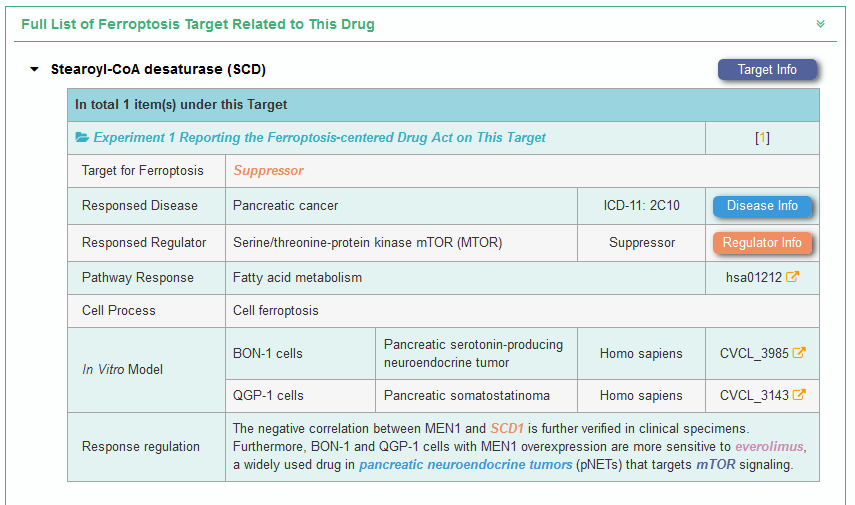
4.2. By clicking the “Target” button, the detailed target information page for particular ferroptosis regulator target will be displayed.
Take SCD as an example, “General Information of the ferroptosis Target” section displays the general information of SCD which effect on Everolimus, including its Name, Synonyms, Gene Name, Sequence, Family, Function, Gene ID, Uniprot ID, Target Type, Mechanism Diagram, and External Link(s).
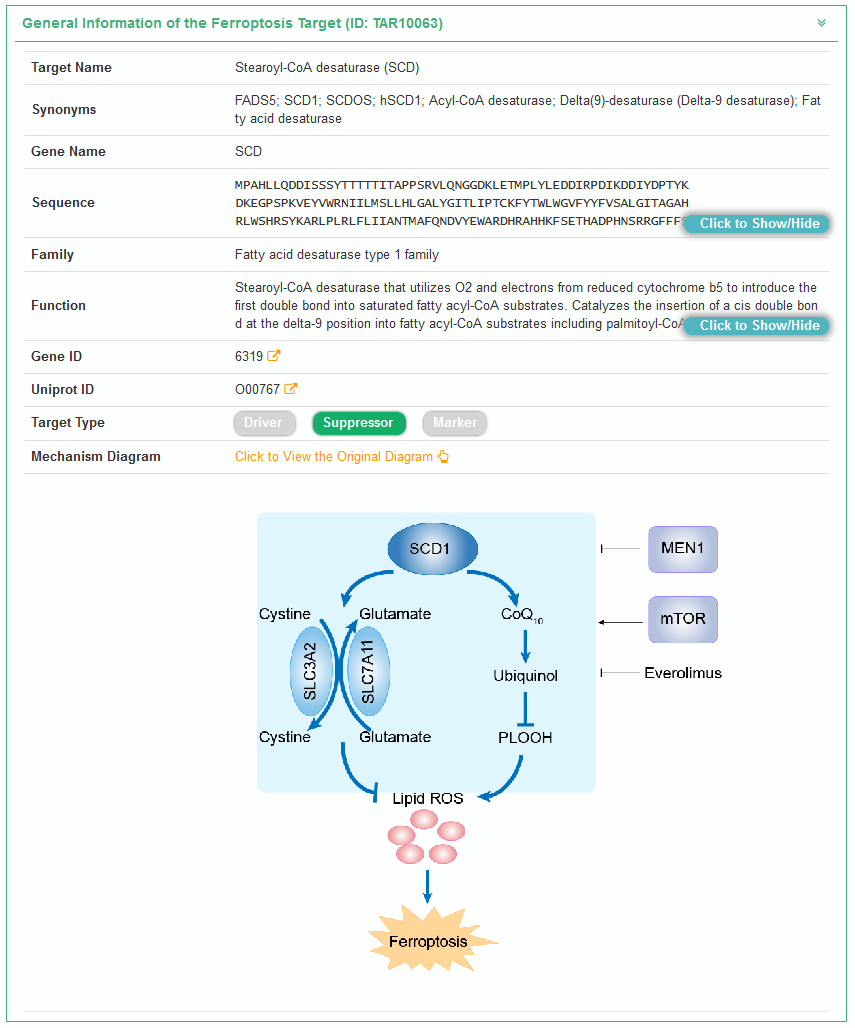
“Full List of ferroptosis Regulator of This Target and Corresponding Disease/Drug Response(s)” section displays the ferroptosis regulator(s) which regulate SCD, and the corresponding Disease/Drug Response(s). Users can browse detail information of regulator(s) or disease/drug(s).
Browse through Disease, the followings are specific experiment reports about the ferroptosis-centered disease of this target.
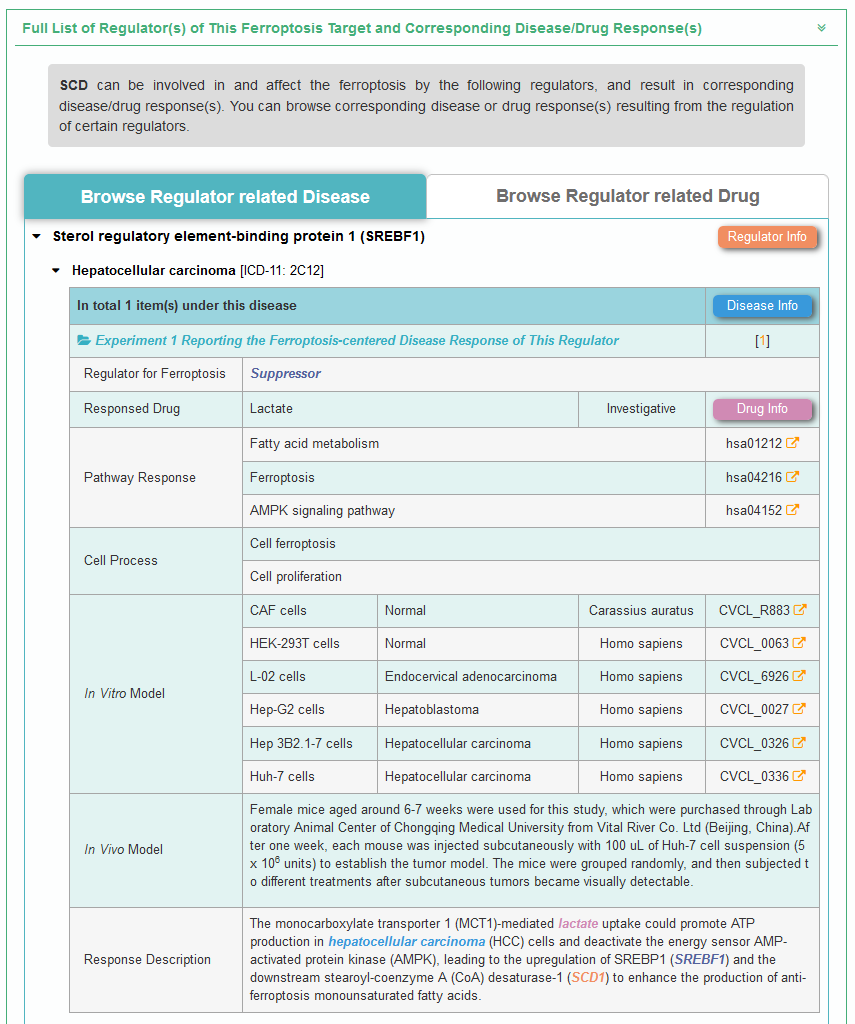
Browse through Drug, the followings are specific experiment reports about the ferroptosis-centered drug of this target.
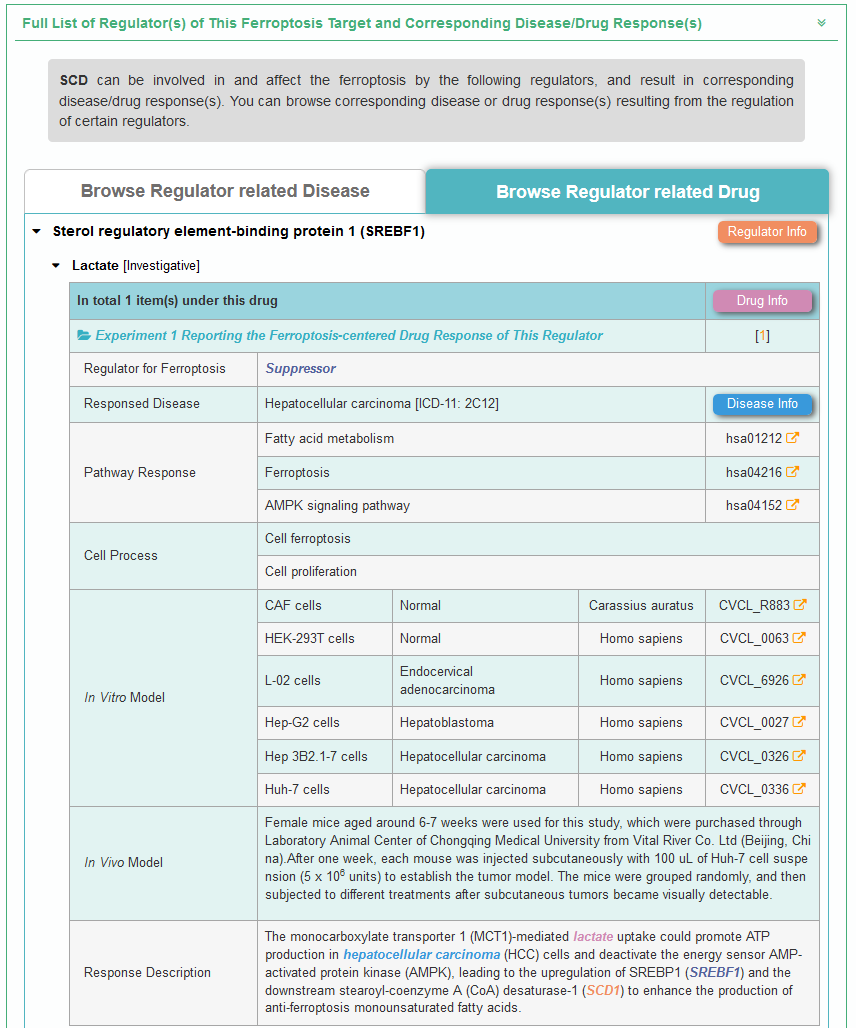
4.3. By clicking the “Disease Info” button, the detailed disease information page for particular “ferroptosis-centered Disease Information” will be displayed.
Take Pancreatic cancer as an example, “General Information of the Disease” section displays the general information of Pancreatic cancer which related with Everolimus, including its Name and ICD.

“Full List of Target(s) of This ferroptosis-centered Disease Response” section displays the target(s) of this ferroptosis-centered disease. The followings are specific experiment reportss about the ferroptosis-centered diseased by the target(s).
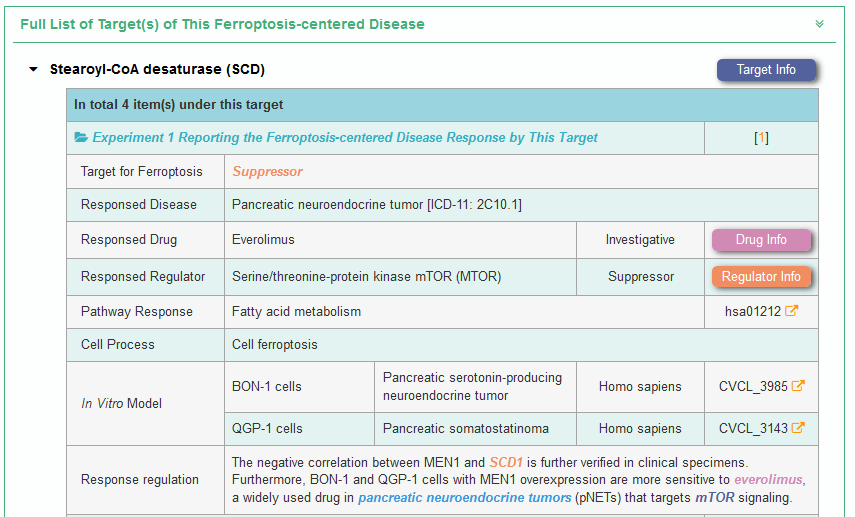
4.4. By clicking the “Regulator Info” button, the detailed ferroptosis regulator information page for particular ferroptosis regulator will be displayed.
Take MEN1 as an example, “General Information of the ferroptosis Regulator” section displays the general information of MEN1 which effect on Everolimus, including its Name, Synonyms, Gene Name, Gene ID, Regulator Type, Sequence, Family, Function, HGNC ID, KEGG ID, and External Link(s).
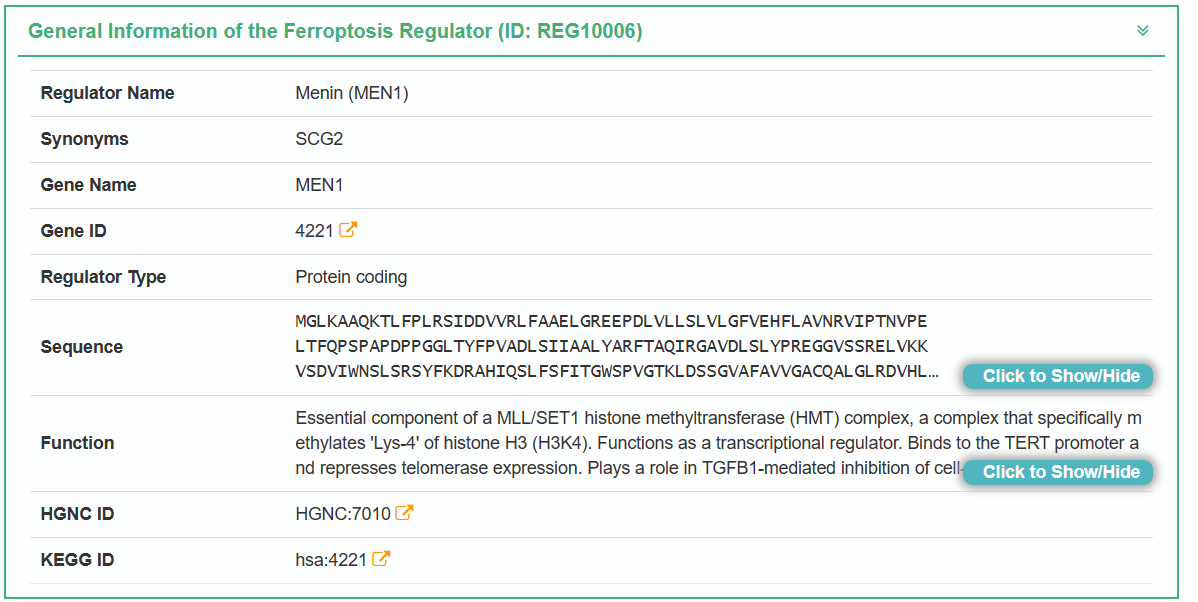
“Full List of ferroptosis target of This ferroptosis Regulator and Corresponding Disease/Drug Response(s)” section displays the MEN1 which regulate ferroptosis target(s), and the corresponding Disease/Drug Response(s). User can browse detail information of regulator(s) or disease/drug(s).
Browse through target, the followings are specific experiment reports about the target of this ferroptosis Regulator, including Target for Ferroptosis, Responsed Disease, Pathway Response, Cell Process, In-vitro Model, In-vivo Model and Response regulation. Target Info button links to the detailed information page with the ferroptosis target. Disease Info button links to the detailed information page with the disease. Drug Info button links to the detailed information page with the drug.
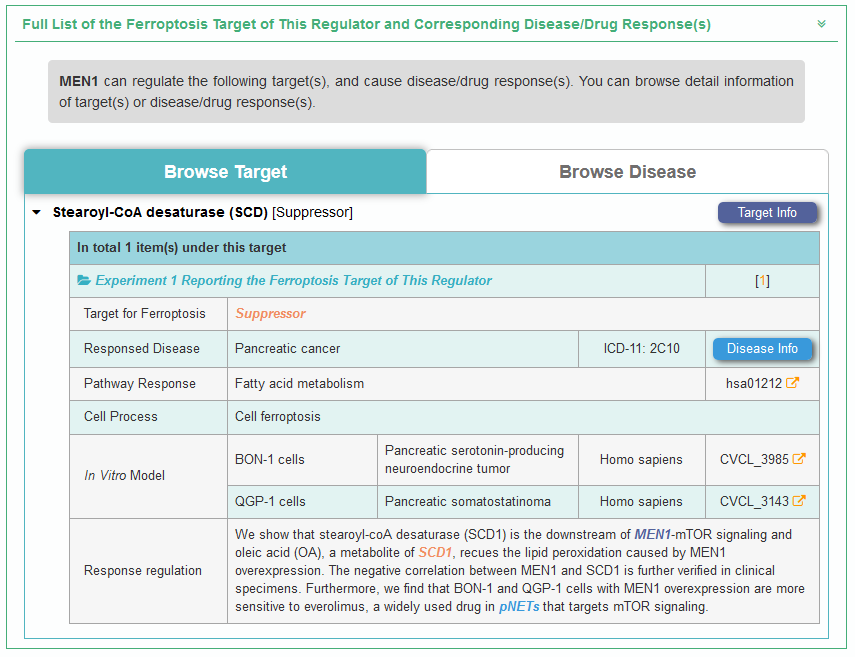
Browse through Disease, the followings are specific experiment reportss about the ferroptosis-centered disease of this ferroptosis Regulator, including Target Regulator, Responsed Drug, Pathway Response, Cell Process, In-vitro Model, and Response regulation. Disease Info button links to the detailed information page with the disease. Regulator Info button links to the detailed information page with the ferroptosis regulator. Drug Info button links to the detailed information page with the drug.
